Quick Answer
Current fashion trends for men in the Spring of 2025 are dominated by an increasing prevalence of elevated casual menswear and relaxed silhouettes, departing from the fitted styles of last year.
The top 3 current fashion trends are:
- Wide-leg Trousers (replacing skinny fits)
- Oversized Blazers (in sage green, butter yellow, cream)
- Double-breasted Cotton Blazers (replacing wool versions)
Key Points to Remember
- While there’s a general overlap in these fashion trends, they are interpreted differently across global fashion capitals such as New York, London, Tokyo, Milano or Paris.
- The current fashion trends are influenced by the post-pandemic return to the office and a new wave of workplace dress codes.
- Comfort and sophistication are merging, with relaxed silhouettes becoming increasingly acceptable in formal settings.
Want to learn more? Continue reading the full article below ↓
This comprehensive guide on current fashion trends stands apart for three crucial reasons:
- We analyse each trend’s manifestation across different global markets, from London to New York and Sao Paolo to Tokyo and Sydney.
- We explain why specific clothing trends dominate in particular locations while failing to gain traction in others.
- We provide actionable insights with exact measurements, colour specifications, and brand recommendations across various price points.
Let’s explore the 10 most popular fashion trends for men right now, with detailed insights into how these trends are interpreted and worn in different global fashion hubs.
1. Wide-Leg Trousers
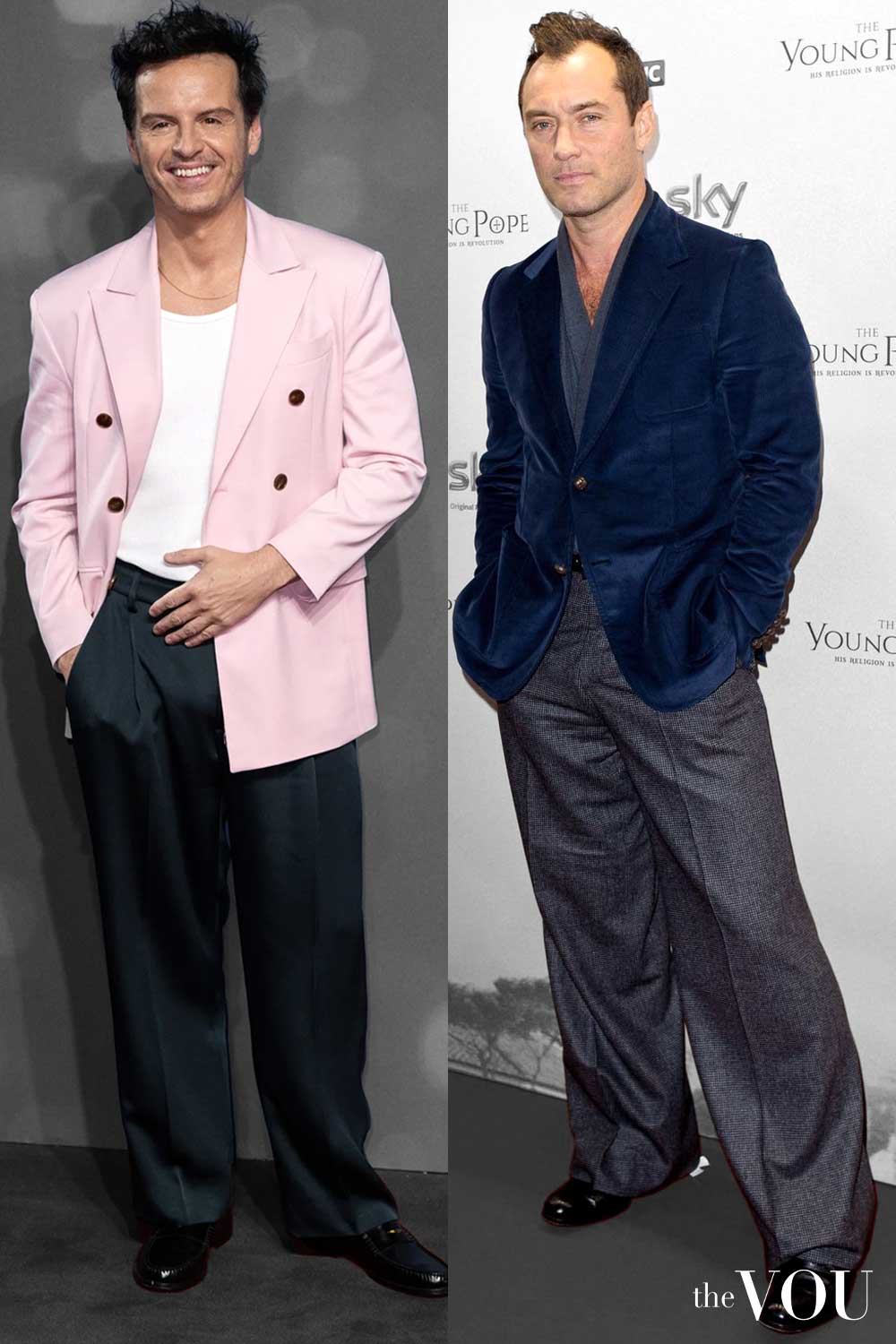
Wide-leg trousers in light grey, charcoal, navy, cream, sand, khaki, oatmeal, olive, and natural undyed tones have emerged as a defining menswear trend for 2025.
Crafted from wool flannel, tropical wool, cotton twill, and linen blends, these relaxed-fit trousers represent the most significant shift in menswear silhouettes since the skinny trouser era of the 2010s.
The key elements are a higher rise, front pleats, and a generous leg opening that creates a dramatic vertical line when paired with fitted tops.
NYC (SoHo, TriBeCa, Financial District)
@aguynamedpatrick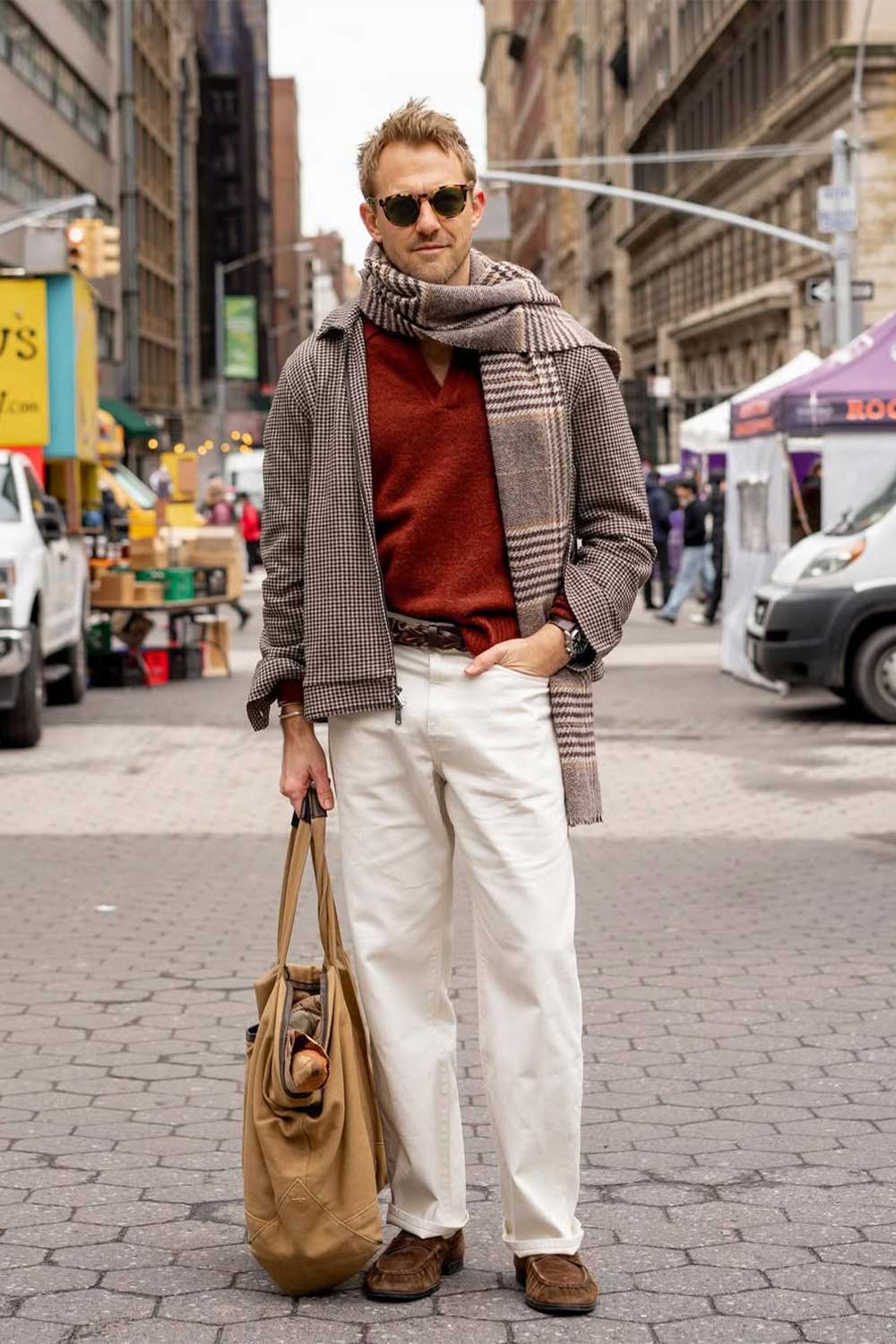 |
@benbrewster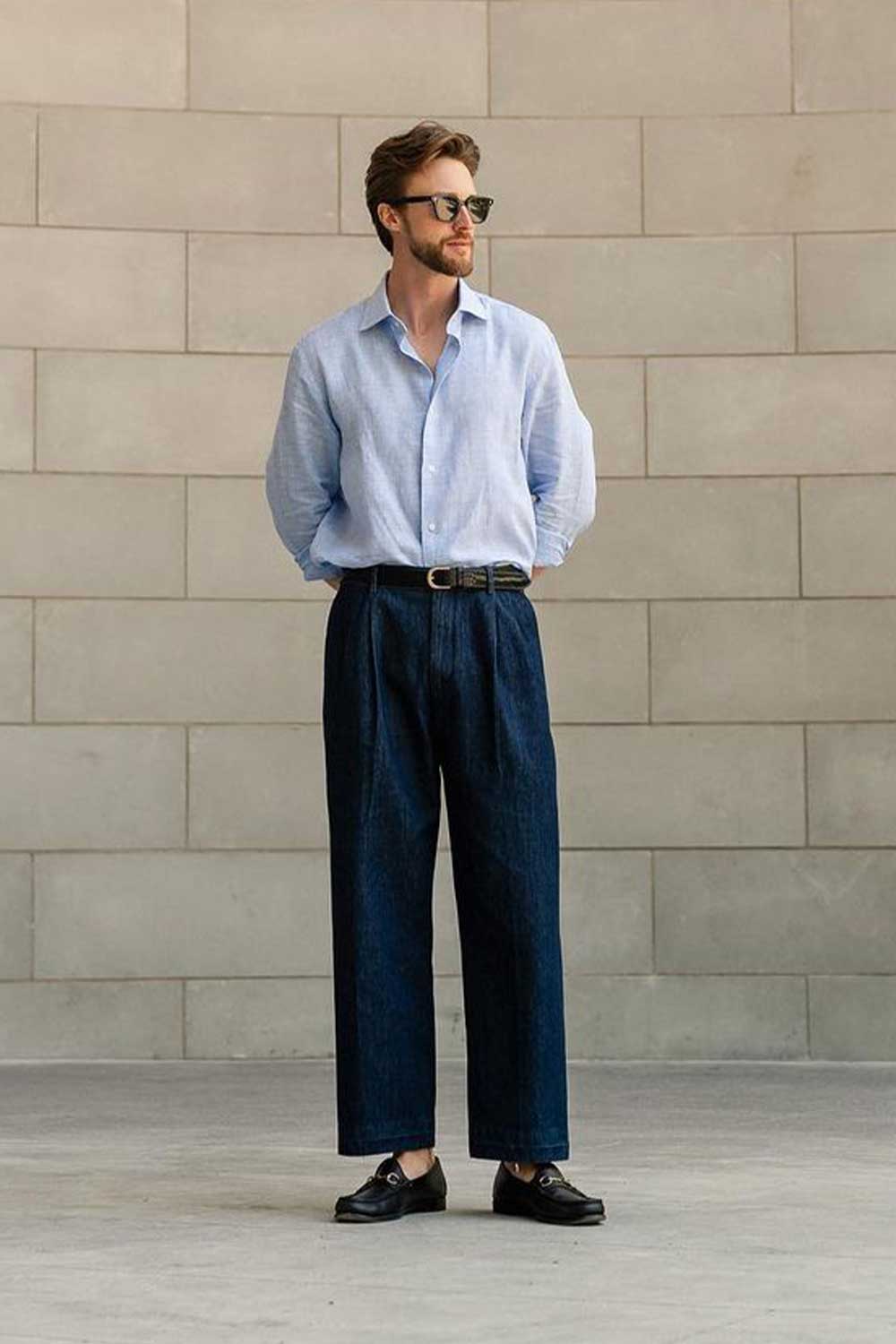 |
@stephoncarson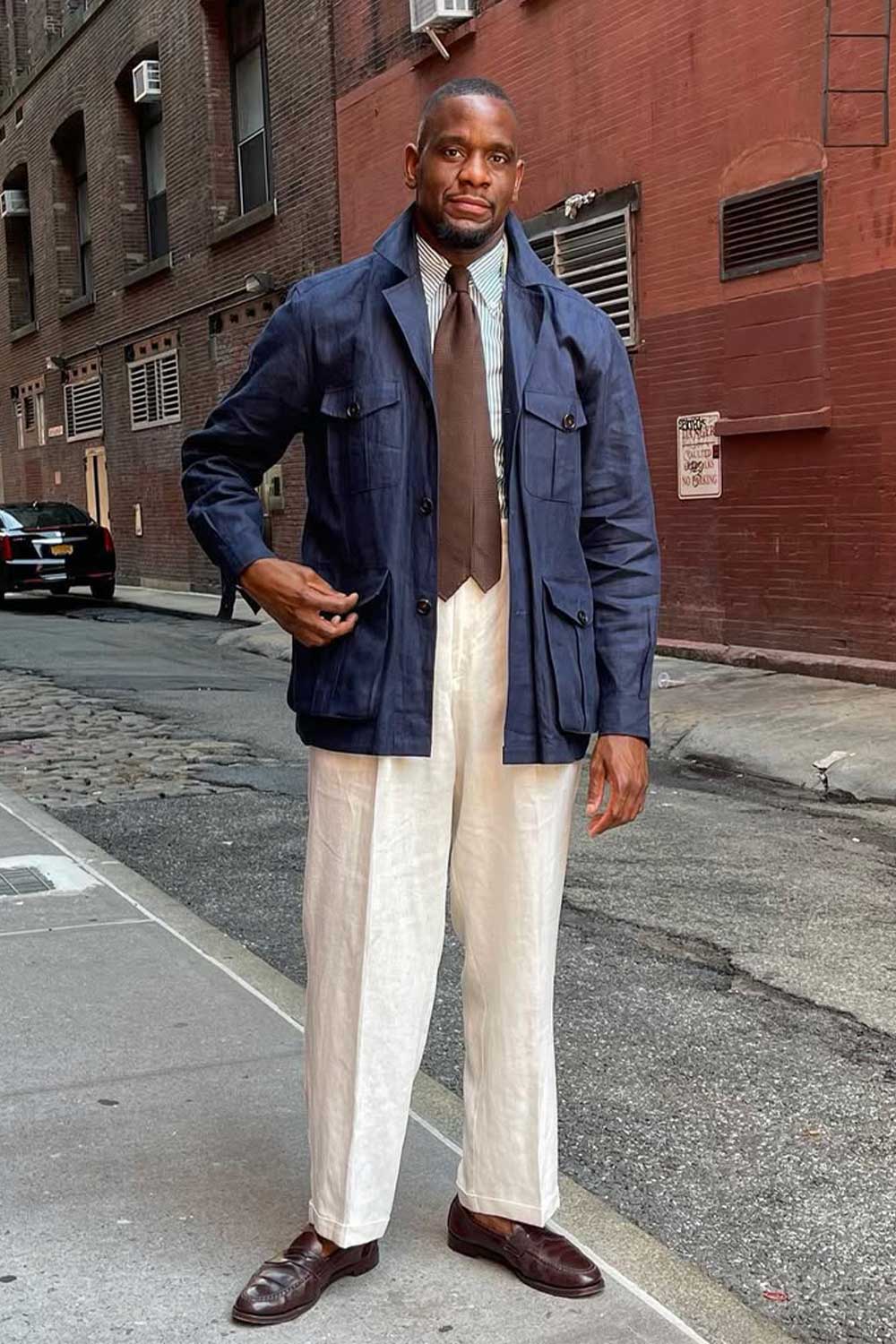 |
@l__mohand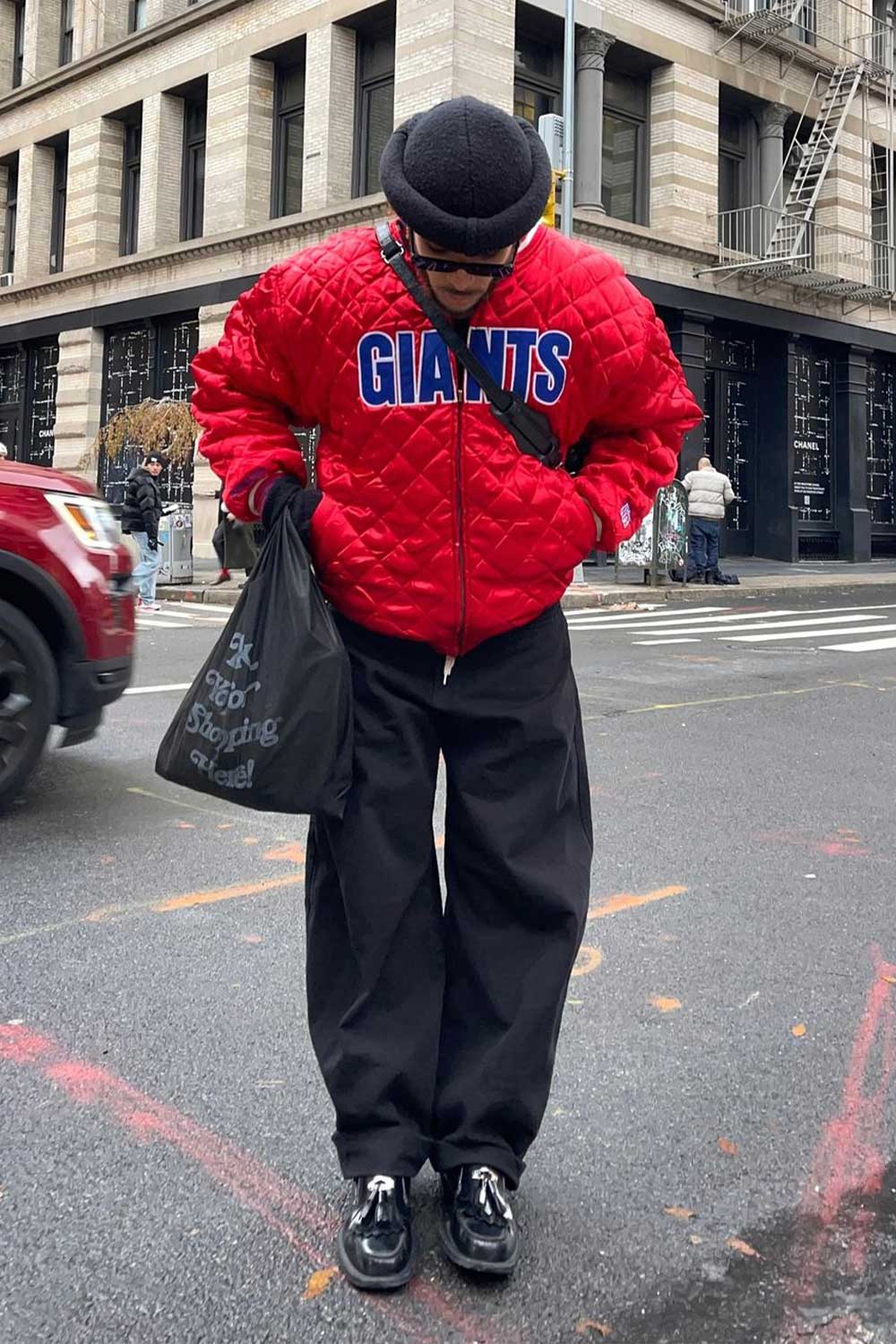 |
@dimichka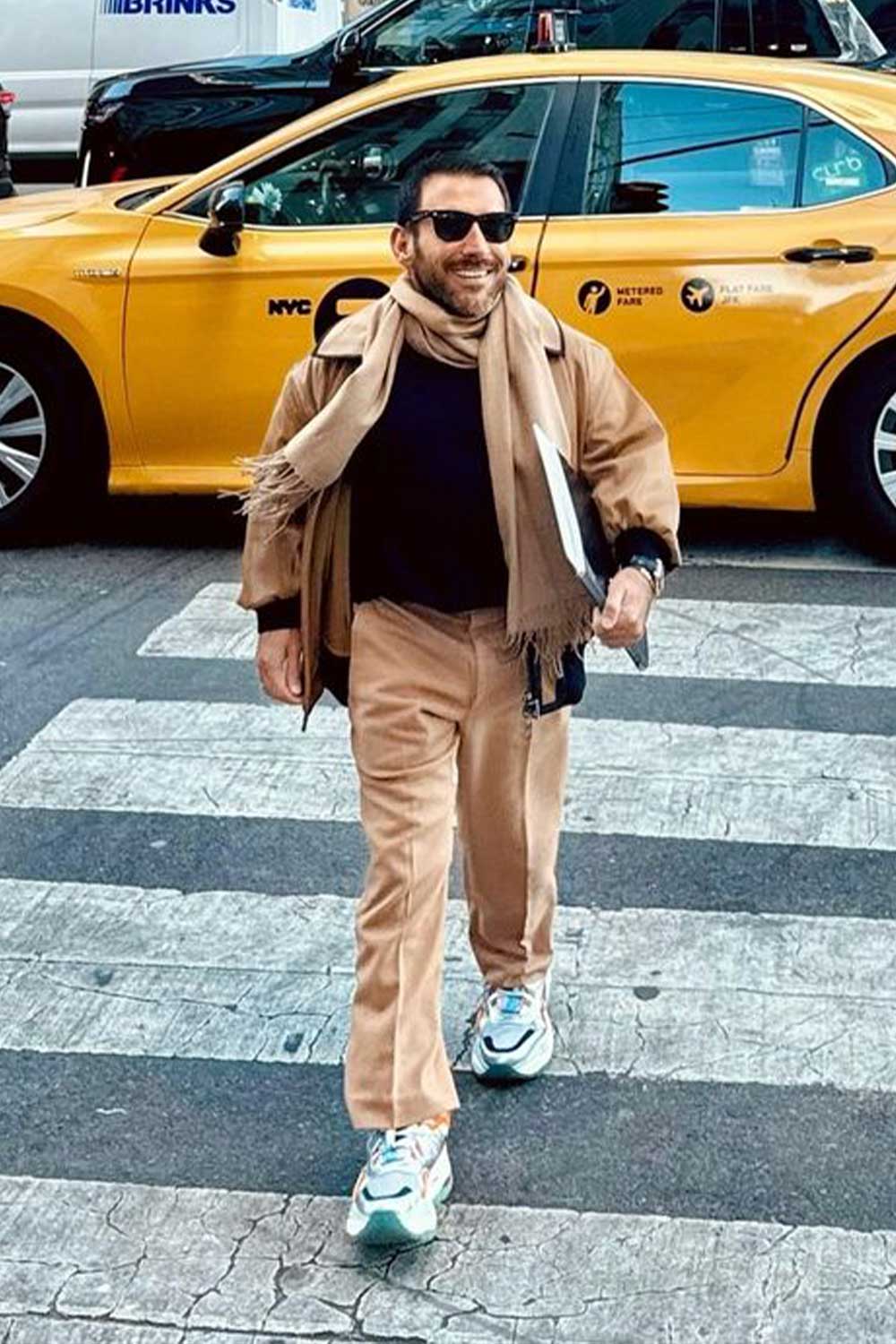 |
@johngreenacre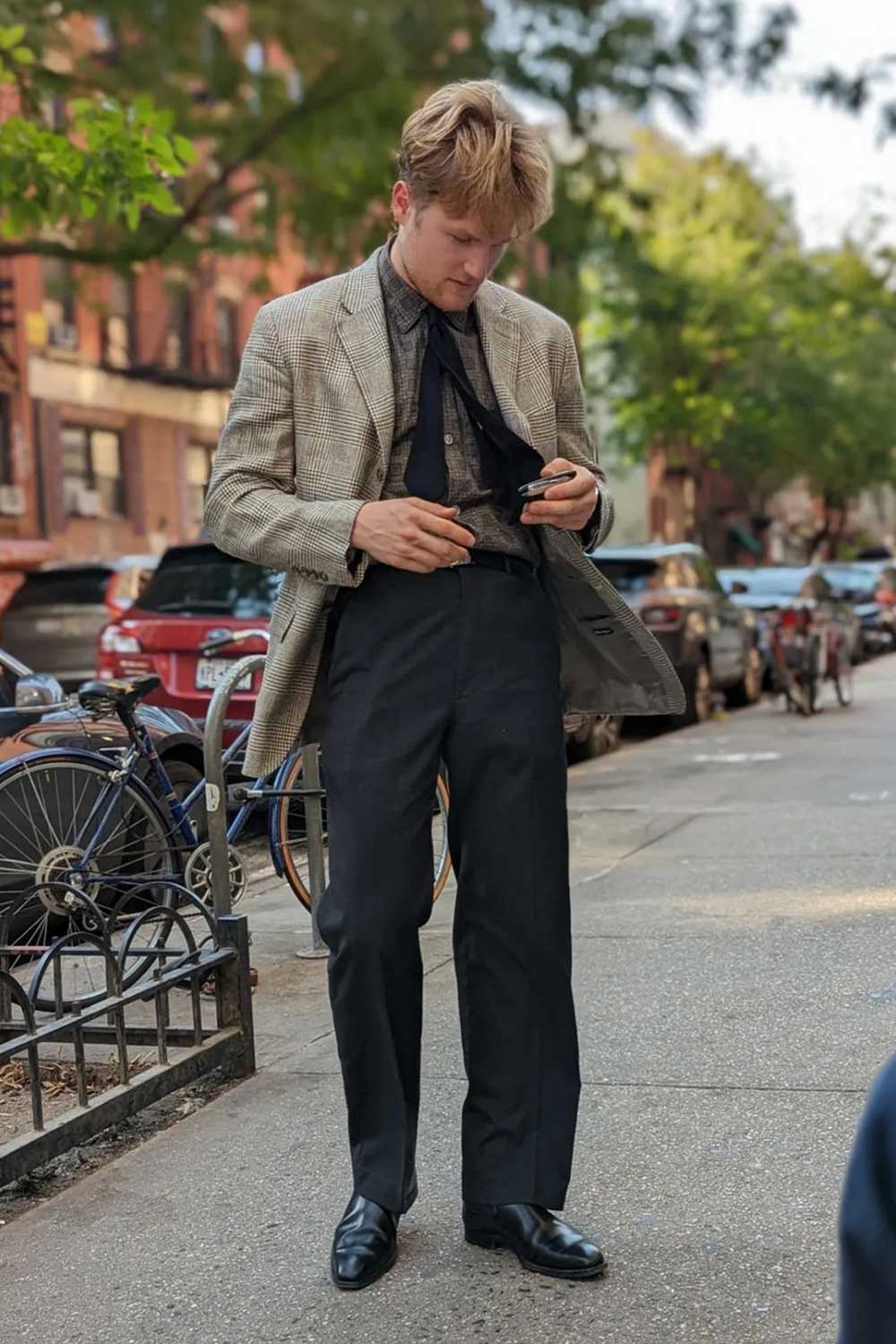 |
Grey wool wide-leg trousers dominate NYC’s professional scene as a direct response to the post-pandemic return to office.
Silicon Alley tech companies and creative agencies have adopted them as the new power move, replacing skinny trousers.
The styling is distinctive: grey wide-legs paired with white Common Projects trainers and fitted Merino crewnecks or crisp Oxford shirts.
The look is completed in colder months with oversized wool overcoats in charcoal or camel.
As seen at:
The Row |
Fear of God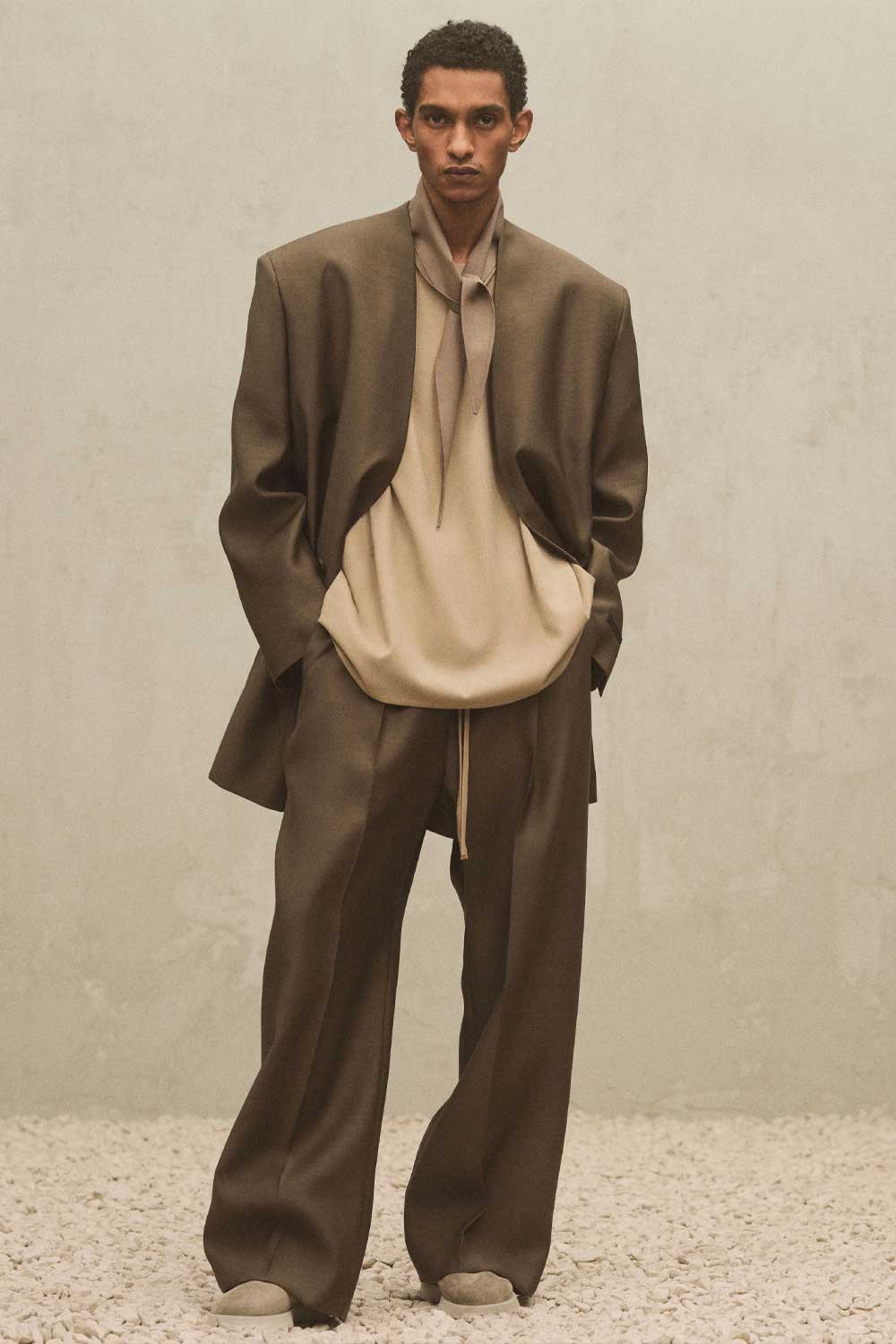 |
Todd Snyder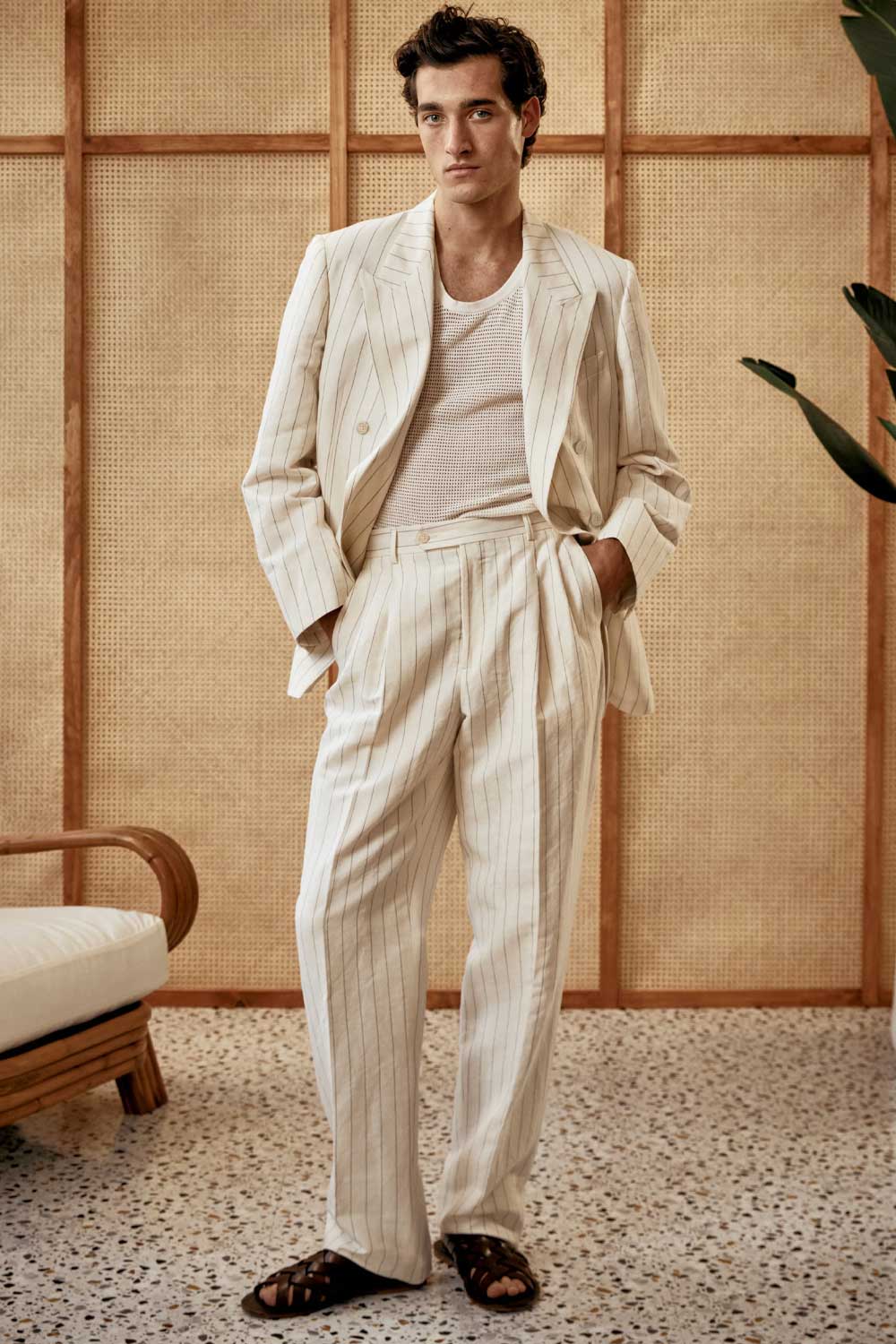 |
Cos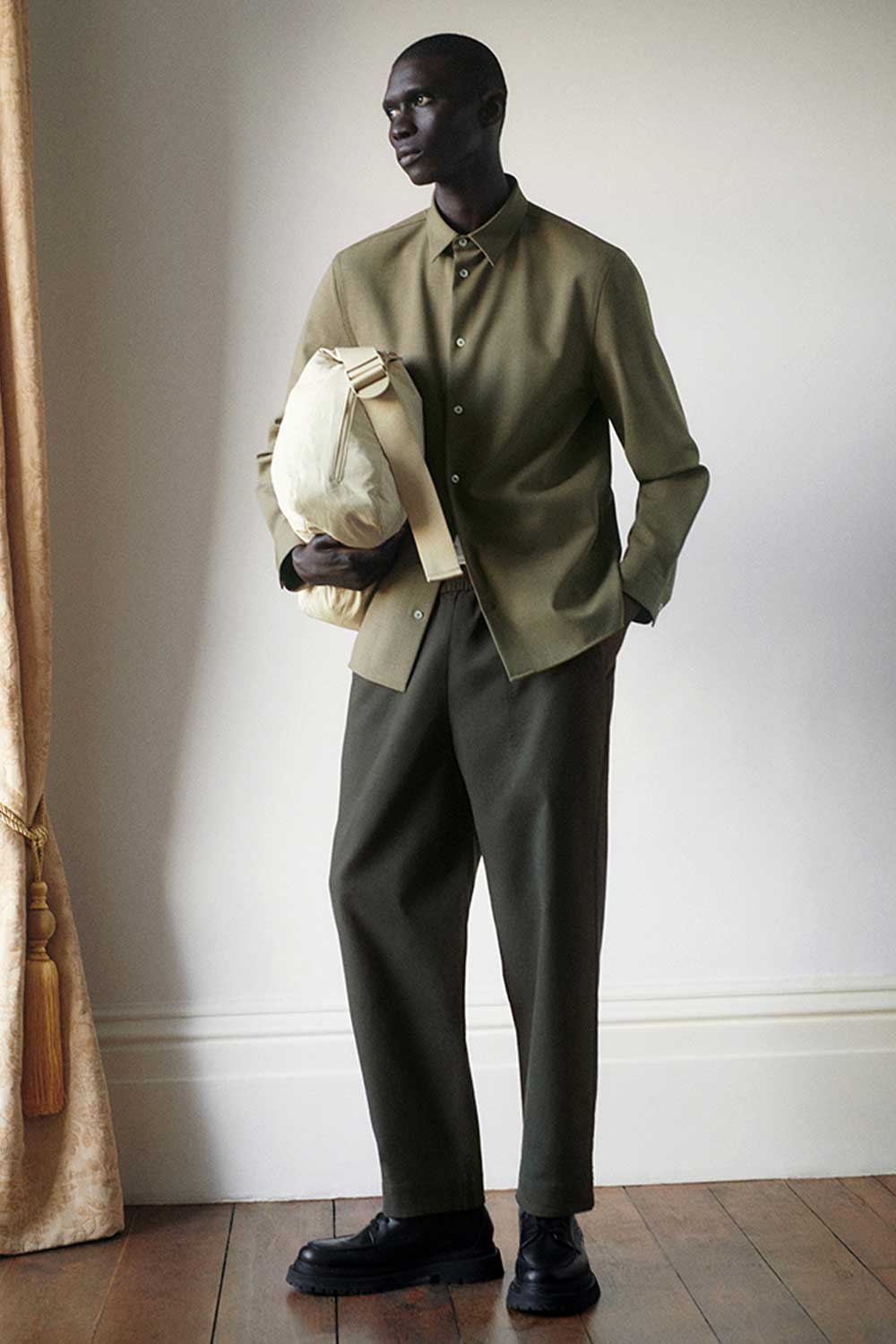 |
Suit Supply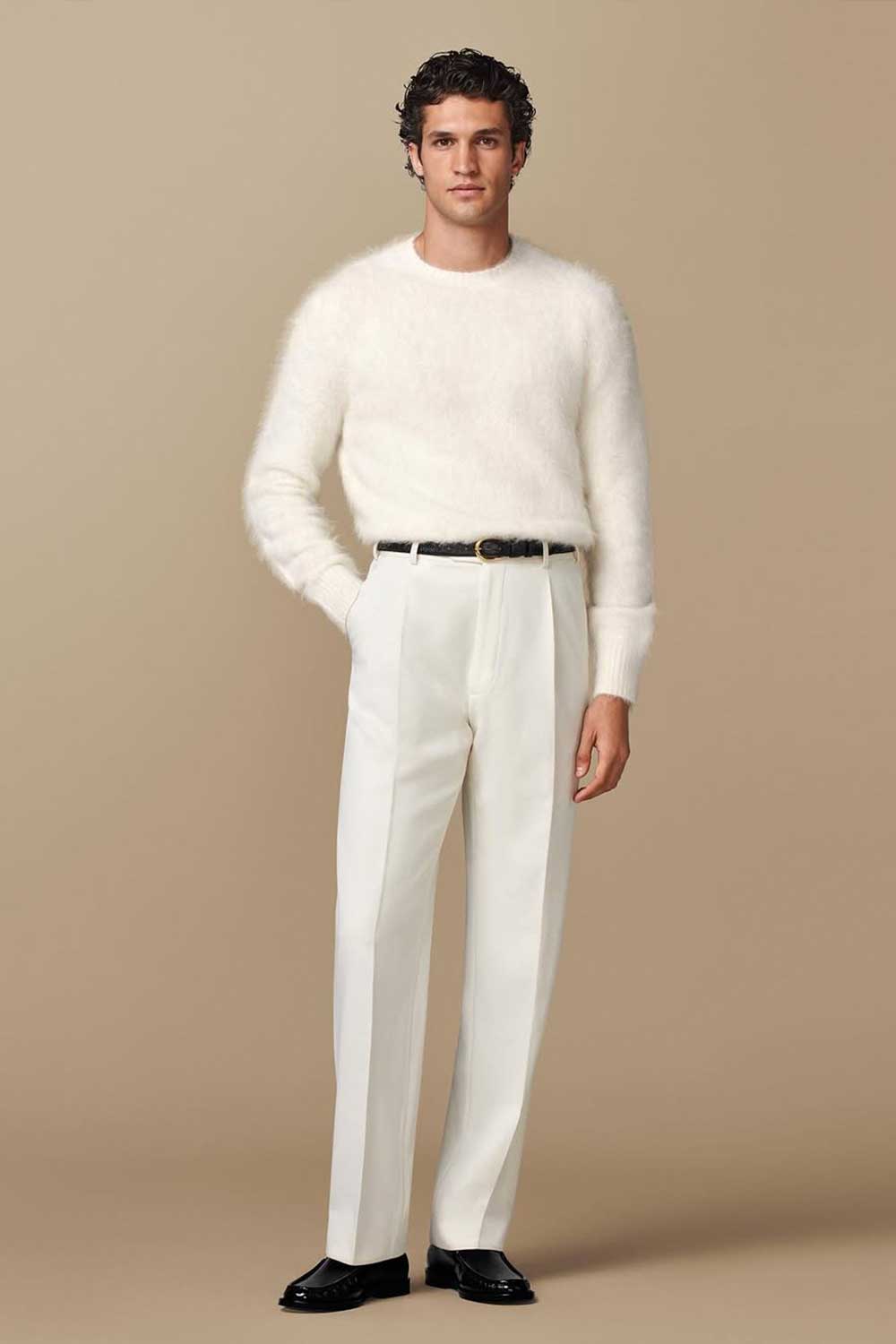 |
Arket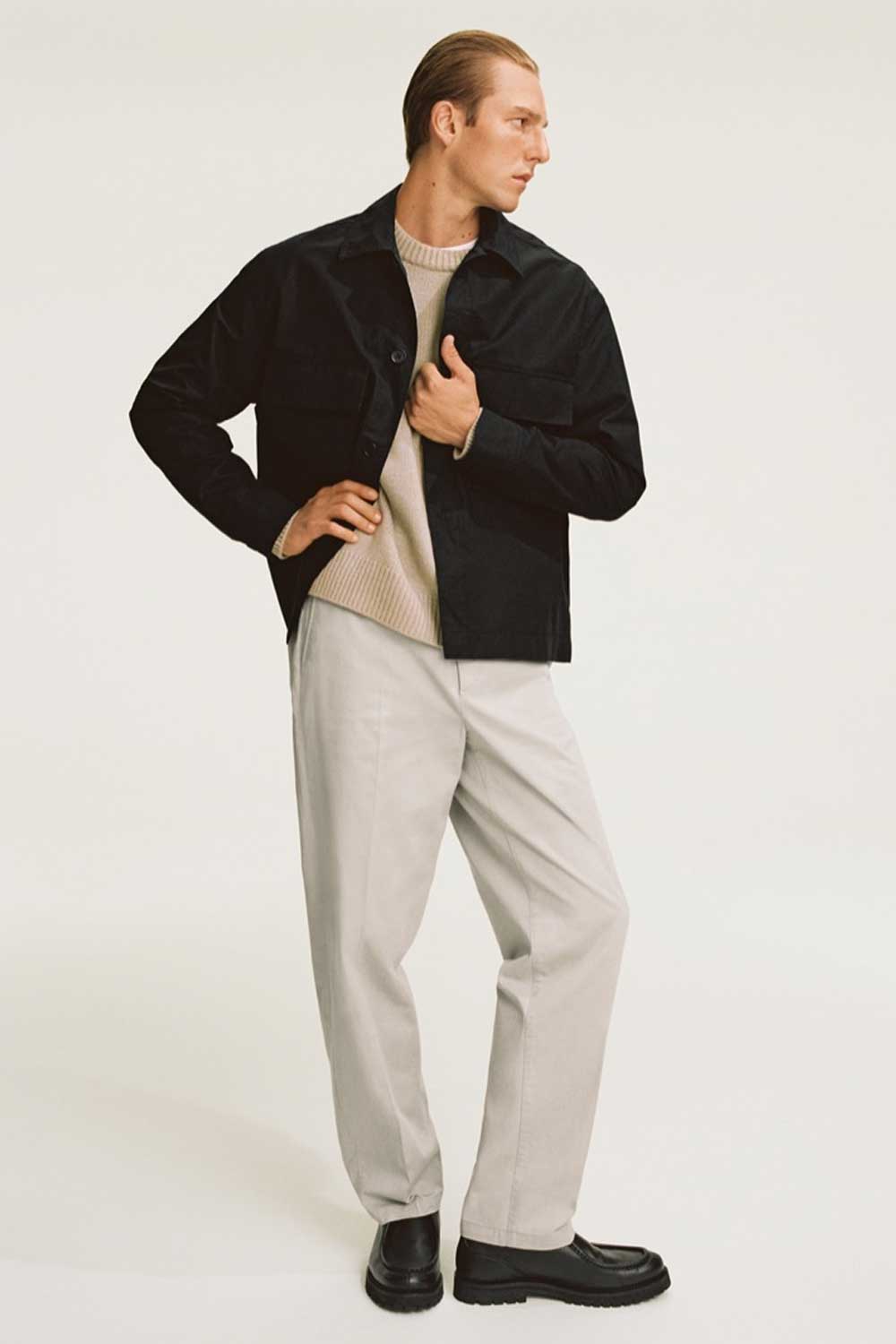 |
This combination has taken over because it bridges the gap between WFH comfort and office presence, signalling an understanding of current luxury codes.
The trend gained momentum when major tech companies like Google and Meta updated their office dress codes, moving away from the hoodie-and-jeans uniform of the 2010s.
London (Shoreditch, Mayfair, City)
@davidgandy_official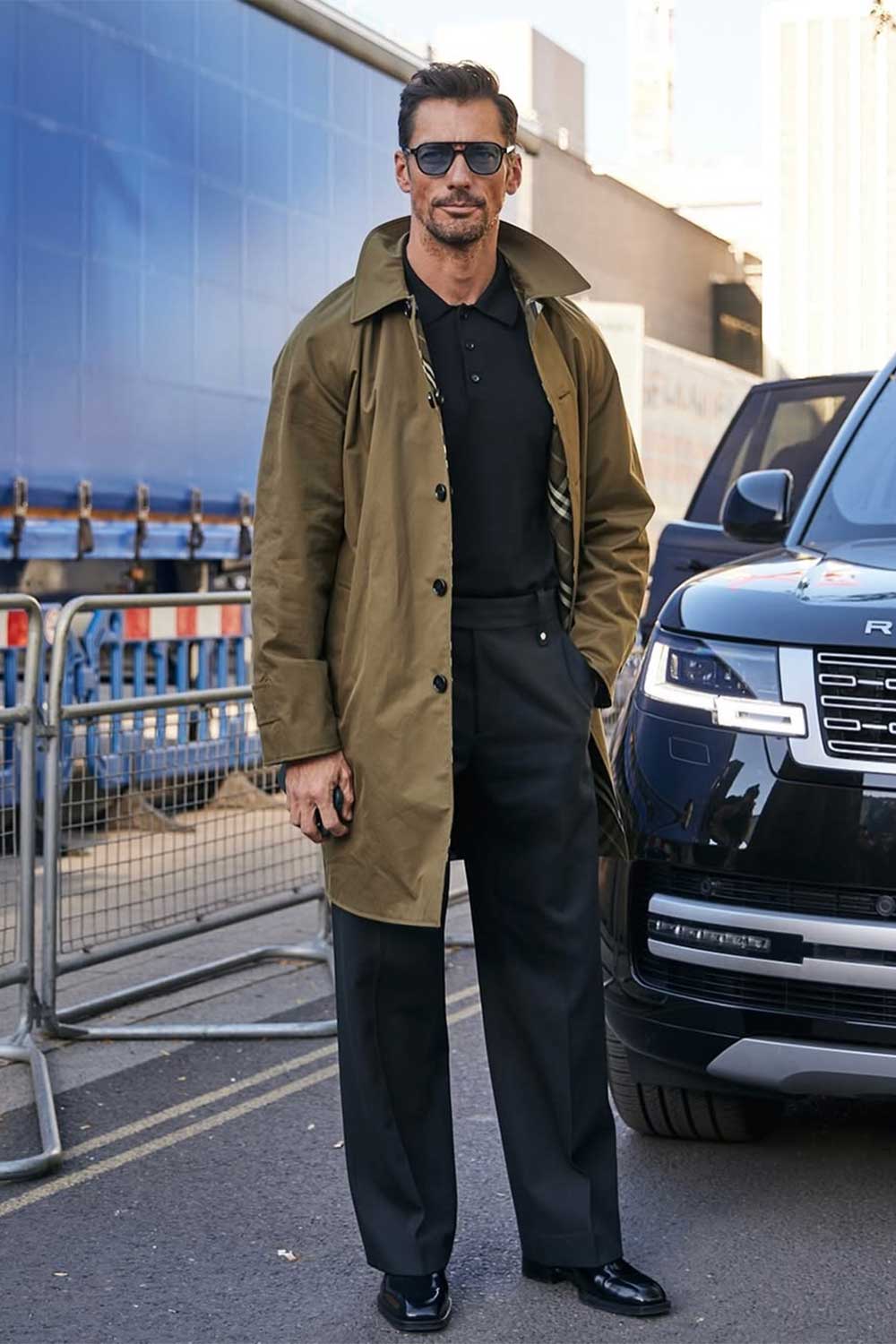 |
@richardbiedul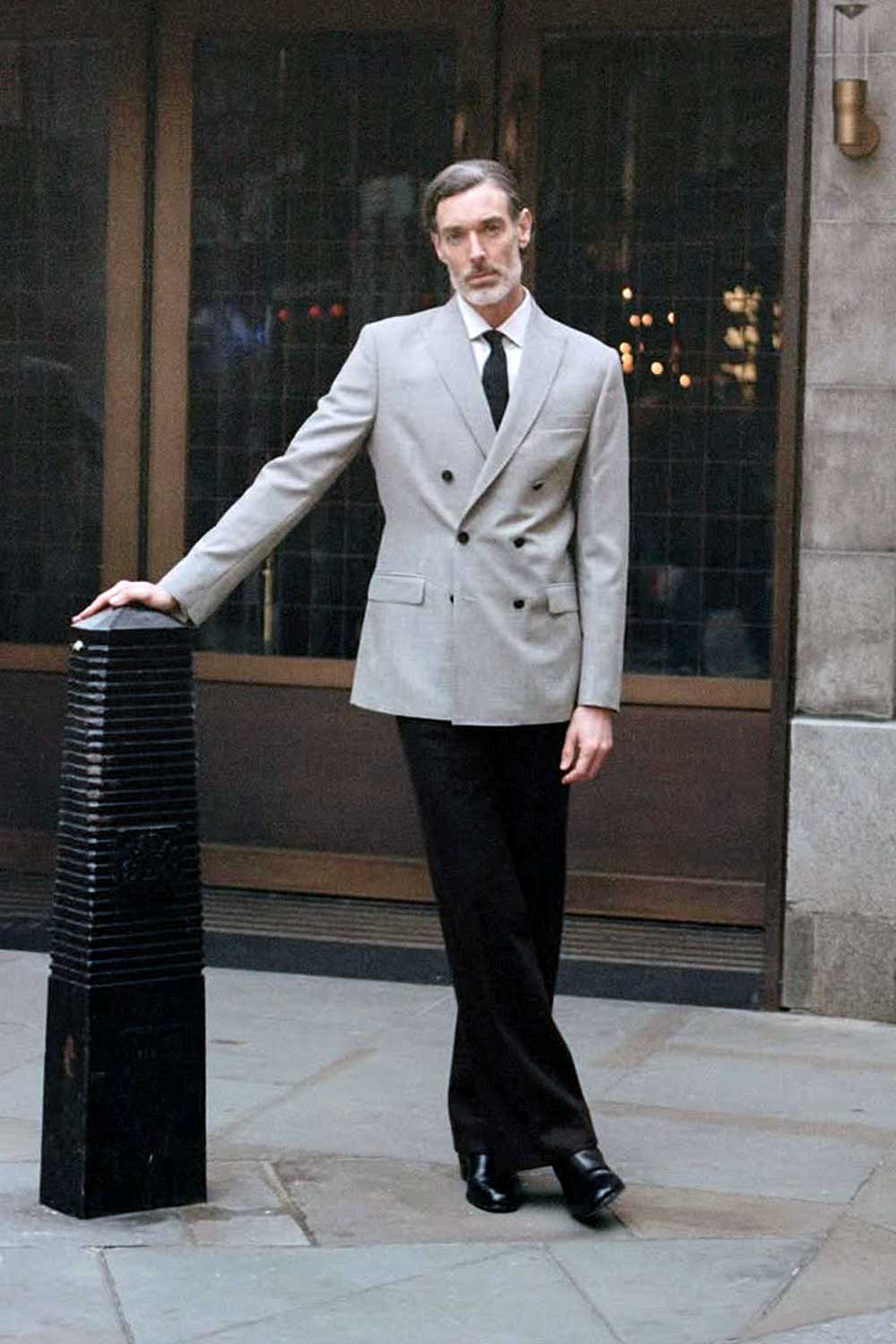 |
@matthewzorpas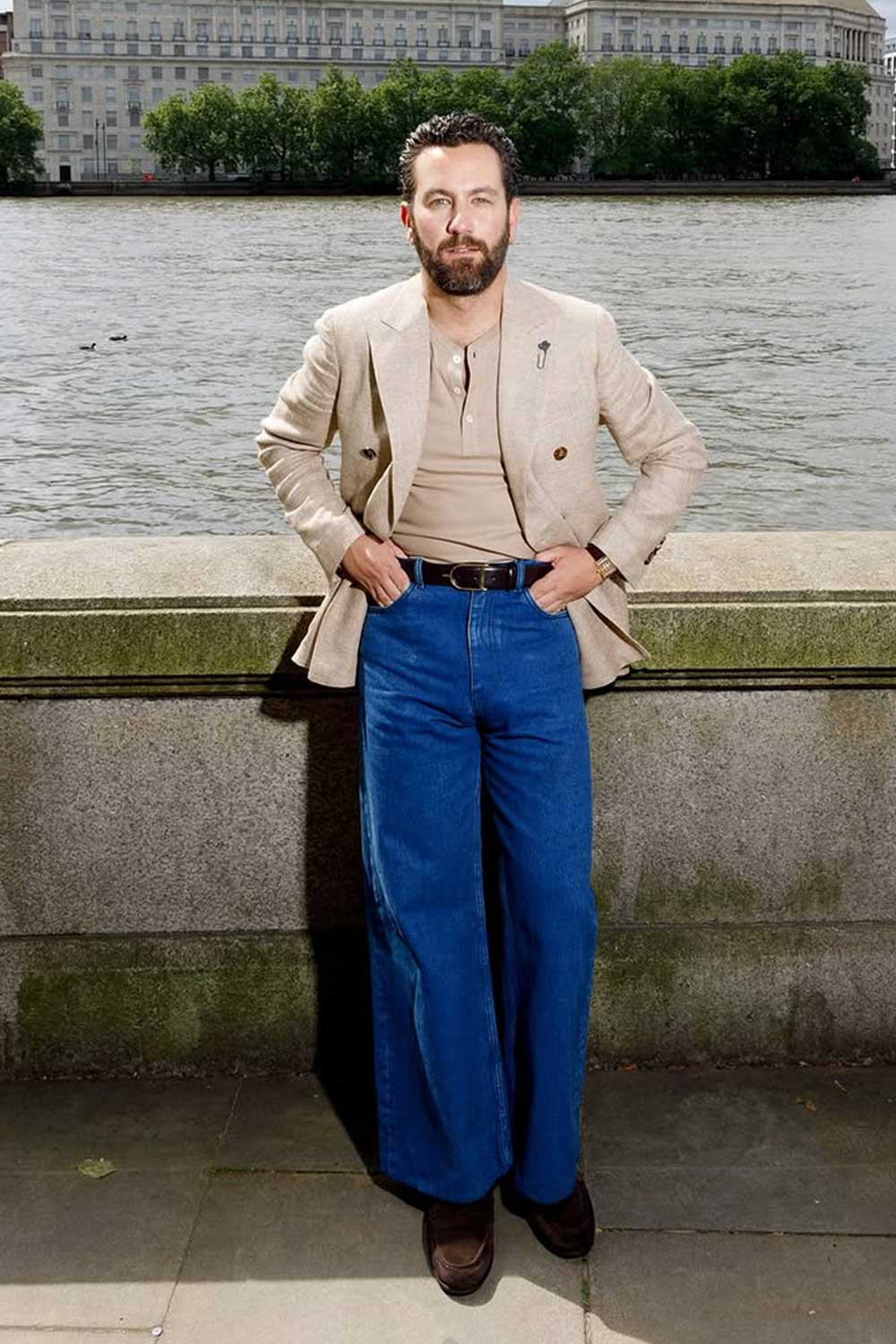 |
@imdanielsimmons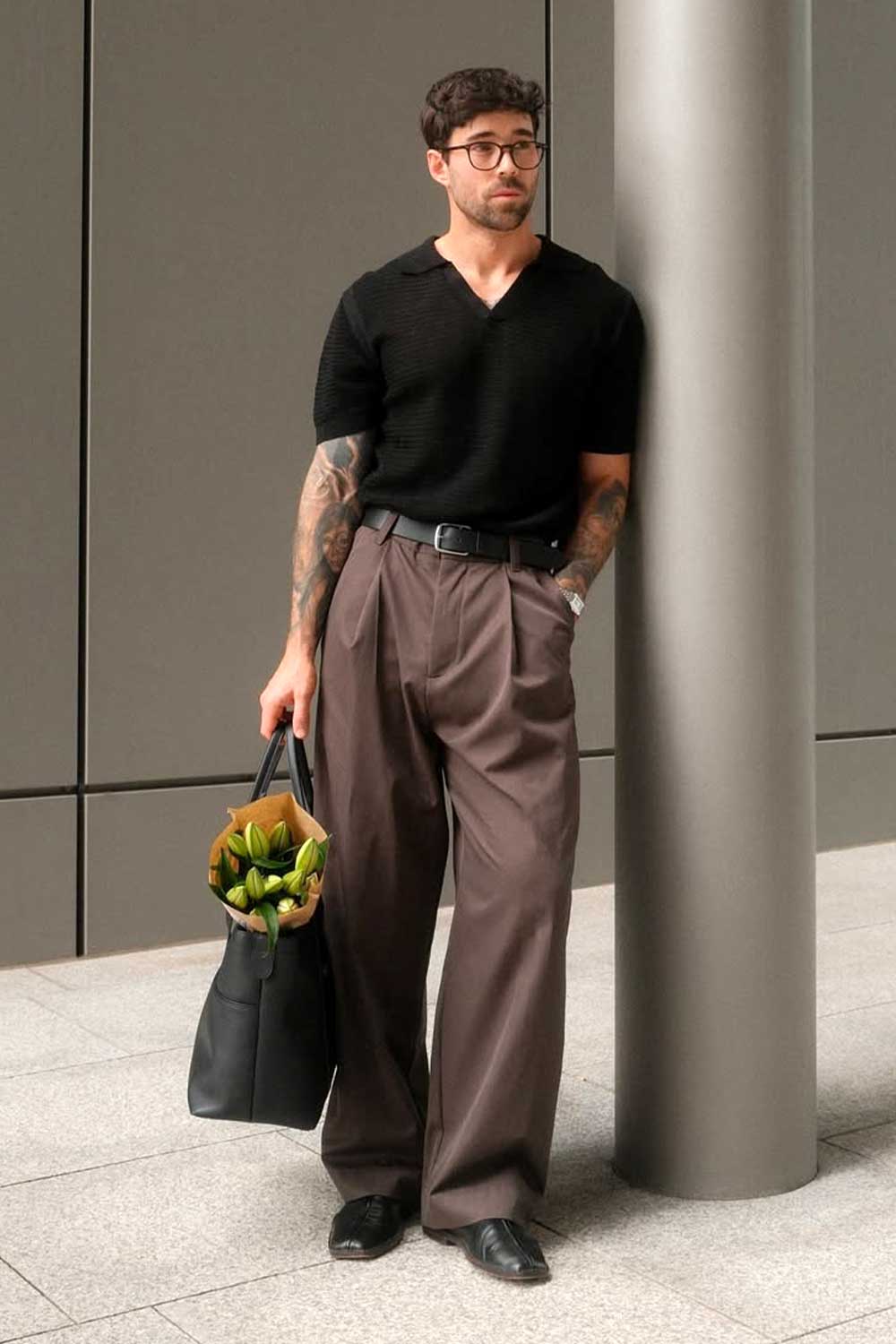 |
@carlthompson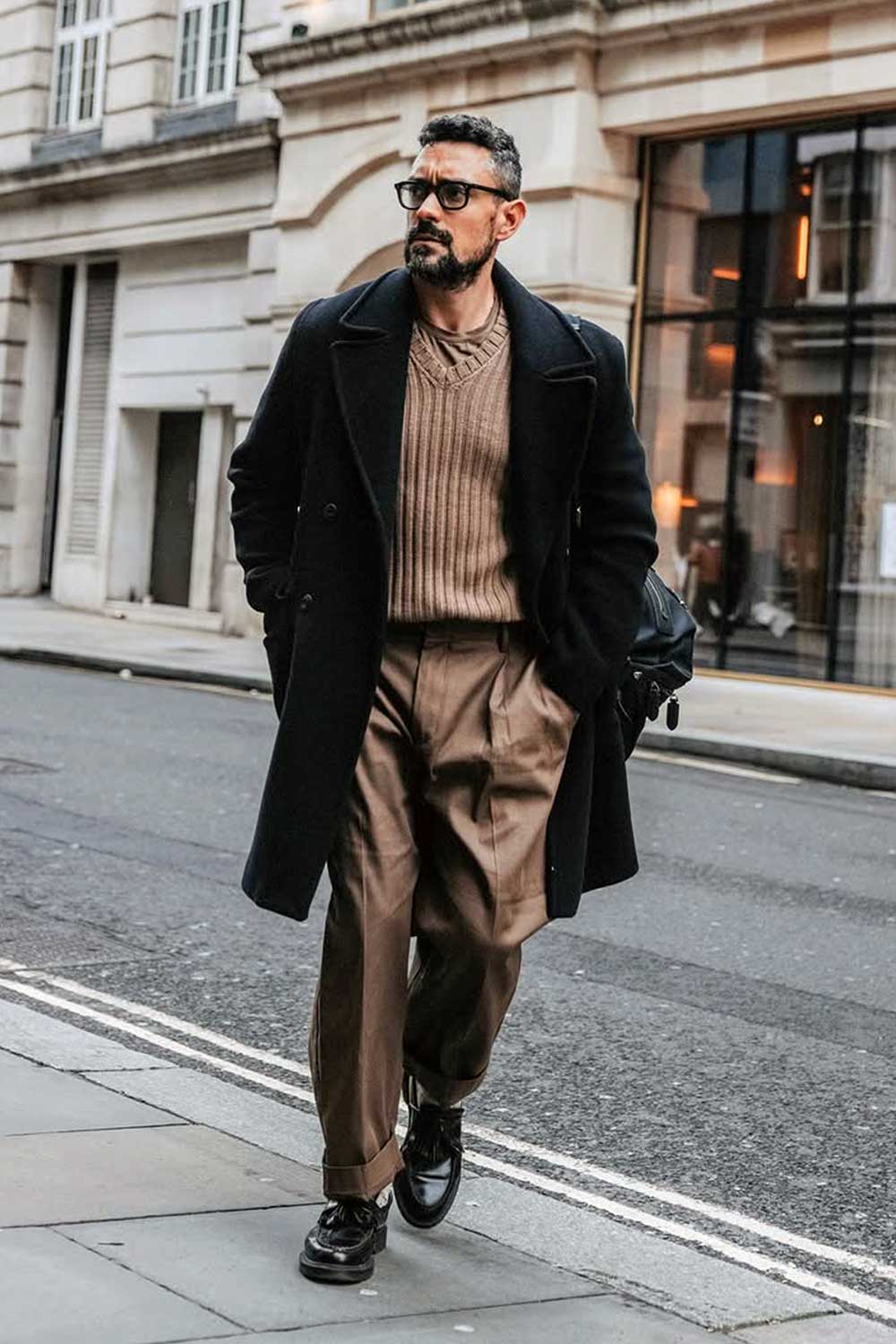 |
@gurjsohanpal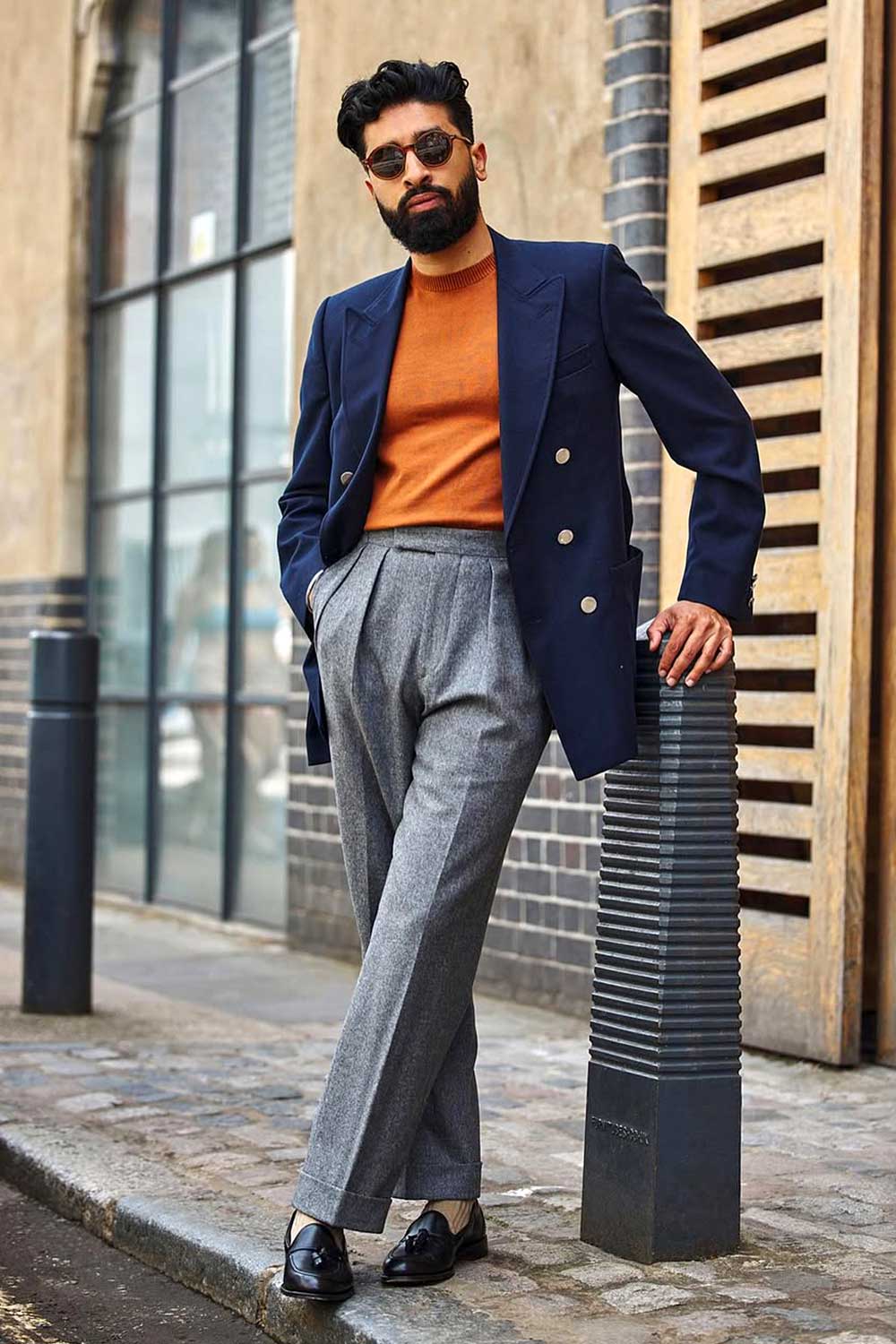 |
Sand and olive cotton wide-legs have revolutionised London’s workwear landscape following the relaxation of financial sector dress codes.
The British interpretation focuses on texture mixing: cotton wide-legs with wool Shetland jumpers and chunky Derby shoes, replacing the traditional pinstripe suit and Oxford combination.
This distinct styling emerged from City bankers adopting more casual codes and East London’s influence on traditional menswear.
The look gained momentum after significant banks like HSBC and Barclays officially abandoned suit requirements, leading to a new hybrid of formal and casual outfits.
As seen at
Drake’s, E. Tautz, Dunhill, A Kind of Guise, Folk, Oliver Spencer, Reiss, COS, Arket
Tokyo (Daikanyama, Aoyama, Ginza)
@kentooyamazaki |
@miyano_mamoru_pr |
@toma.ikuta_official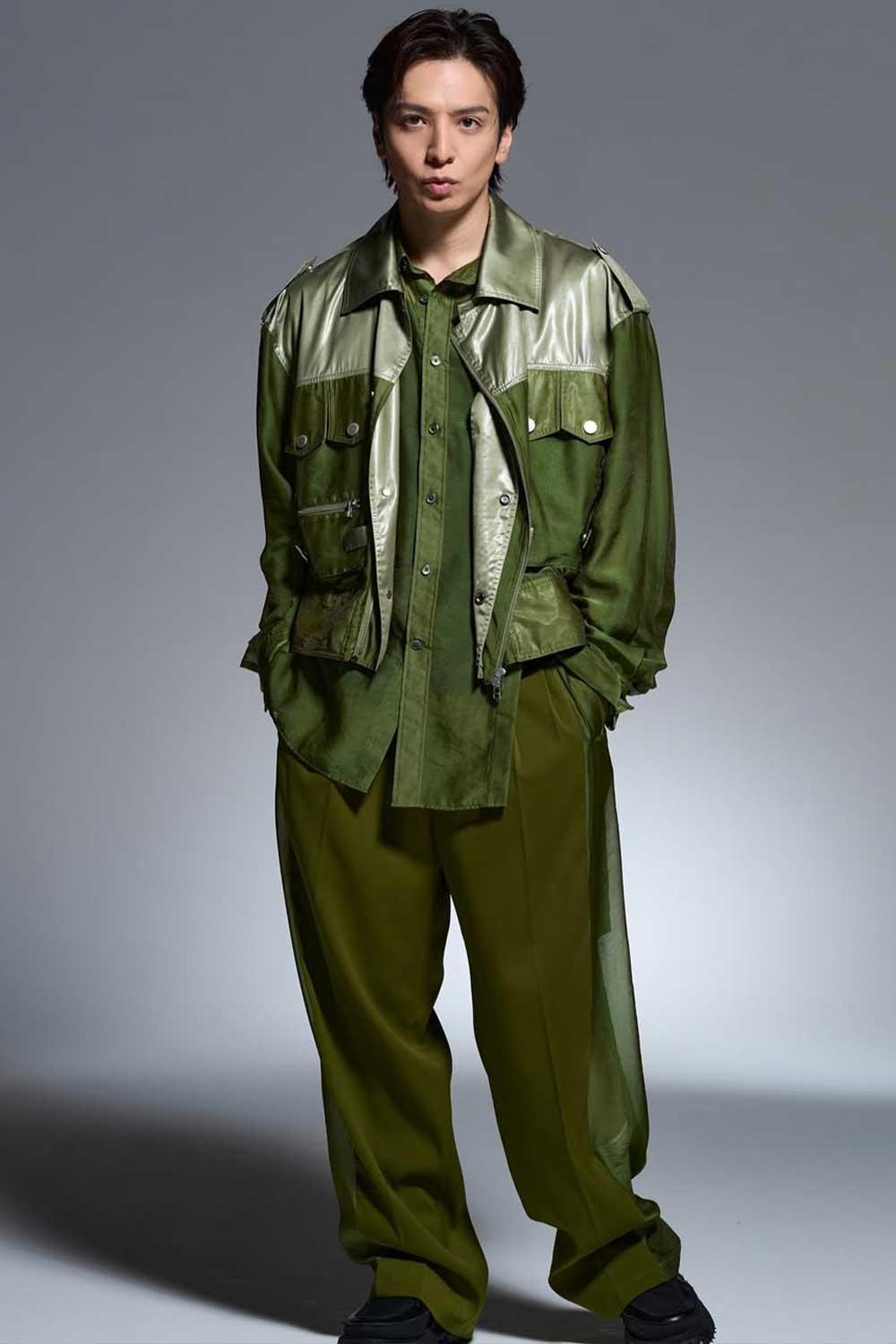 |
@tomo.y9 |
Black wool wide-legs with dramatic volume have become the new standard in Tokyo’s fashion districts, replacing the slim-cut streetwear aesthetic that dominated the past decade.
The Japanese interpretation pairs these voluminous trousers with minimalist Hender Scheme trainers and oversized white cotton poplin shirts, creating a distinctly architectural silhouette.
The trend emerged from Japanese streetwear’s influence on luxury fashion, pioneered by brands like Needles and embraced by the city’s creative professionals.
The look reflects Tokyo’s mastery of volume play in tailoring, a trend that accelerated after Japan’s post-pandemic adoption of looser silhouettes in professional settings.
As seen at
Comme des Garçons, Yohji Yamamoto, Undercover, Needles, United Arrows, Beams Plus, Uniqlo U, GU, Muji, Soshiotsuki
Dubai (DIFC, Dubai Mall, Mall of Emirates)
@mrmoudz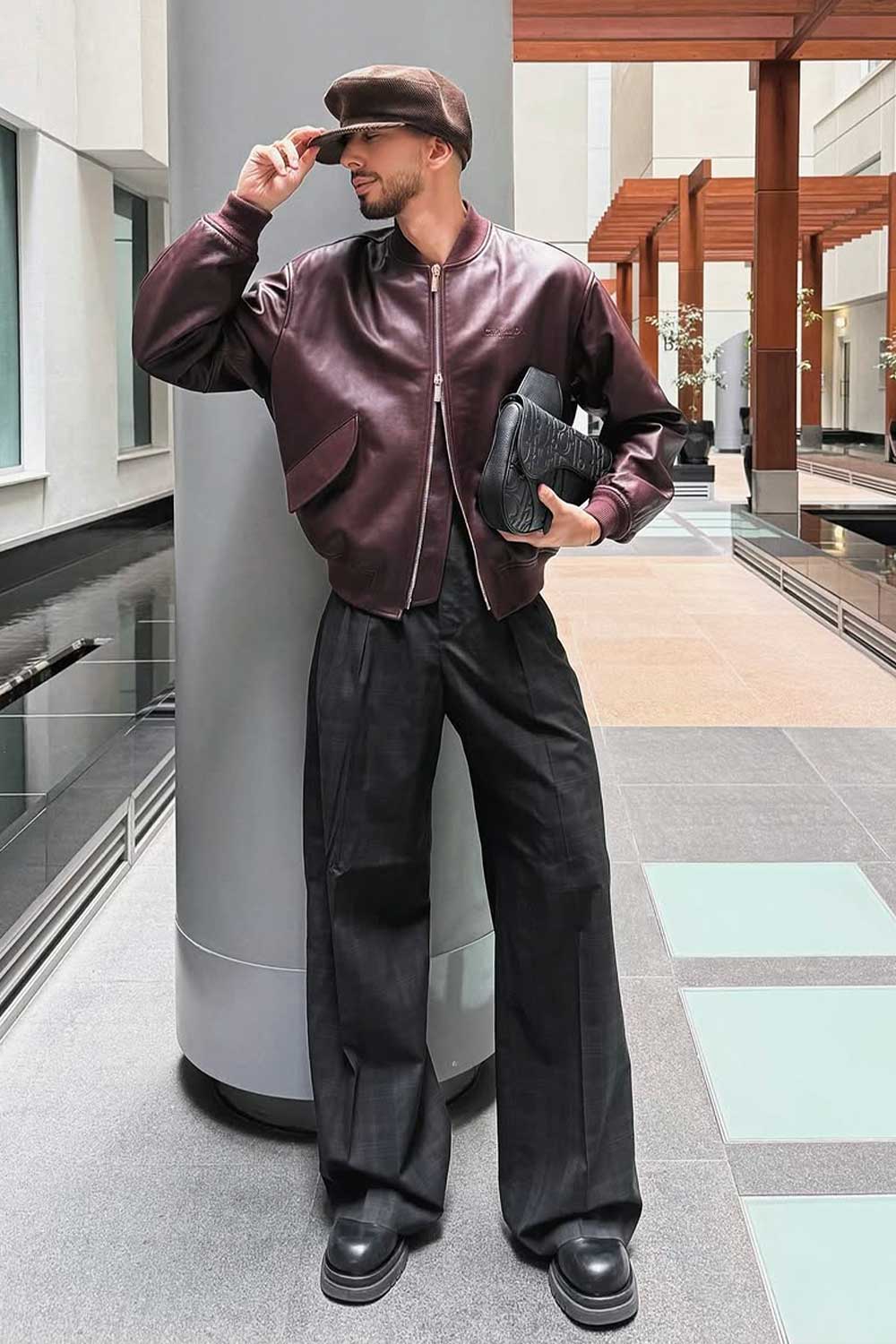 |
@talalkahl |
@twistedcurlz |
The Dubai market has always rejected wide-leg trousers in favour of slim, tapered cuts in technical fabrics.
The prevailing look has featured performance wool blend trousers with stretch, fitted blazers and leather loafers, maintaining the region’s preference for sleek silhouettes.
This preference stems from the need for air-conditioned comfort in extreme heat, the regional appreciation for fitted silhouettes, and the continued influence of European luxury houses in the Middle Eastern market.
Until now!
2025 says goodbye to the technical slim trouser trend.
As seen at
Zegna, Tom Ford, Brioni, Theory, Boss, Canali, Massimo Dutti, Reiss, COS
Milan (Brera, Monte Napoleone, Porta Nuova)
@fabio_la_mantia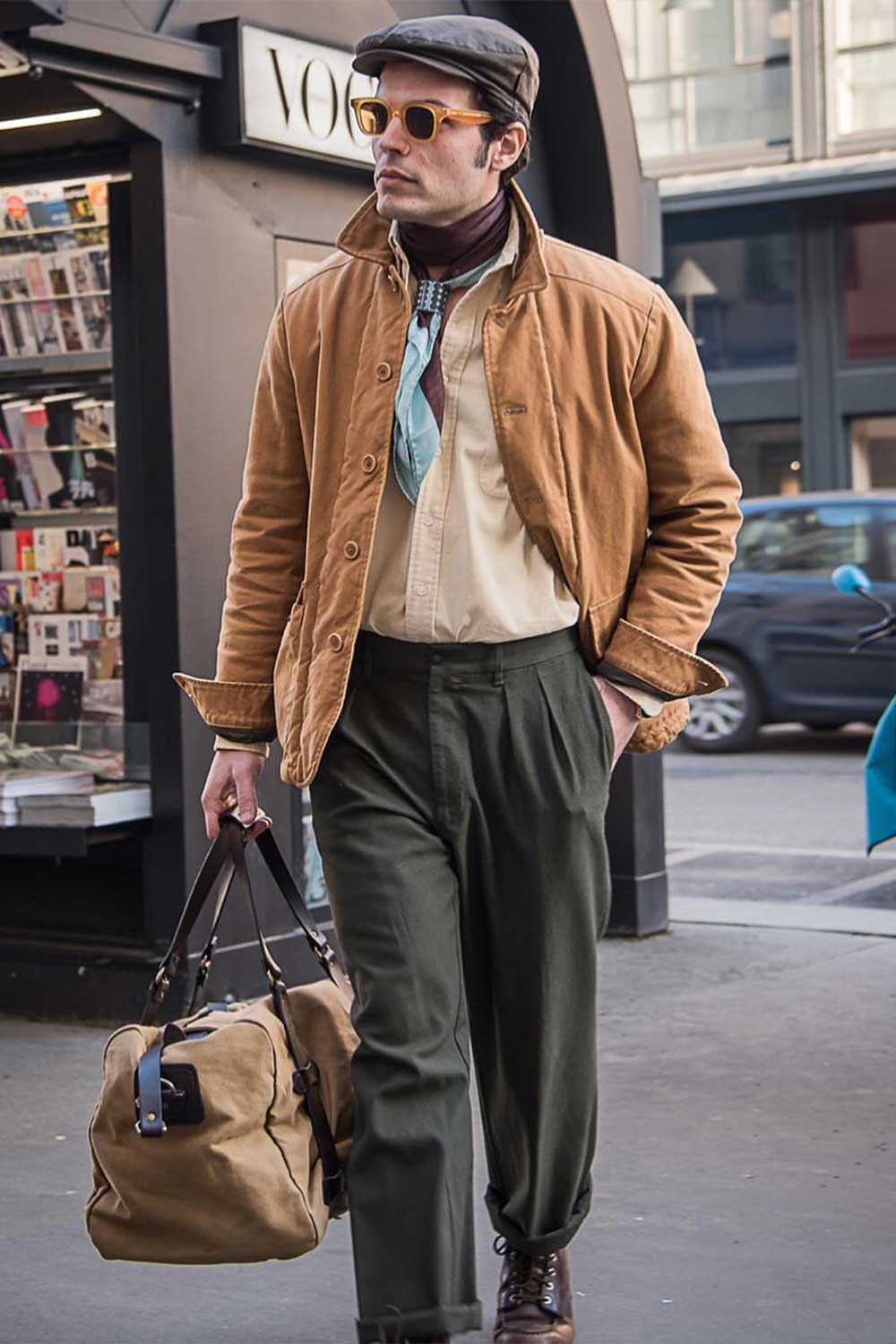 |
@gianfrateshowroom |
@frankgallucci |
@giorgiogiangiulio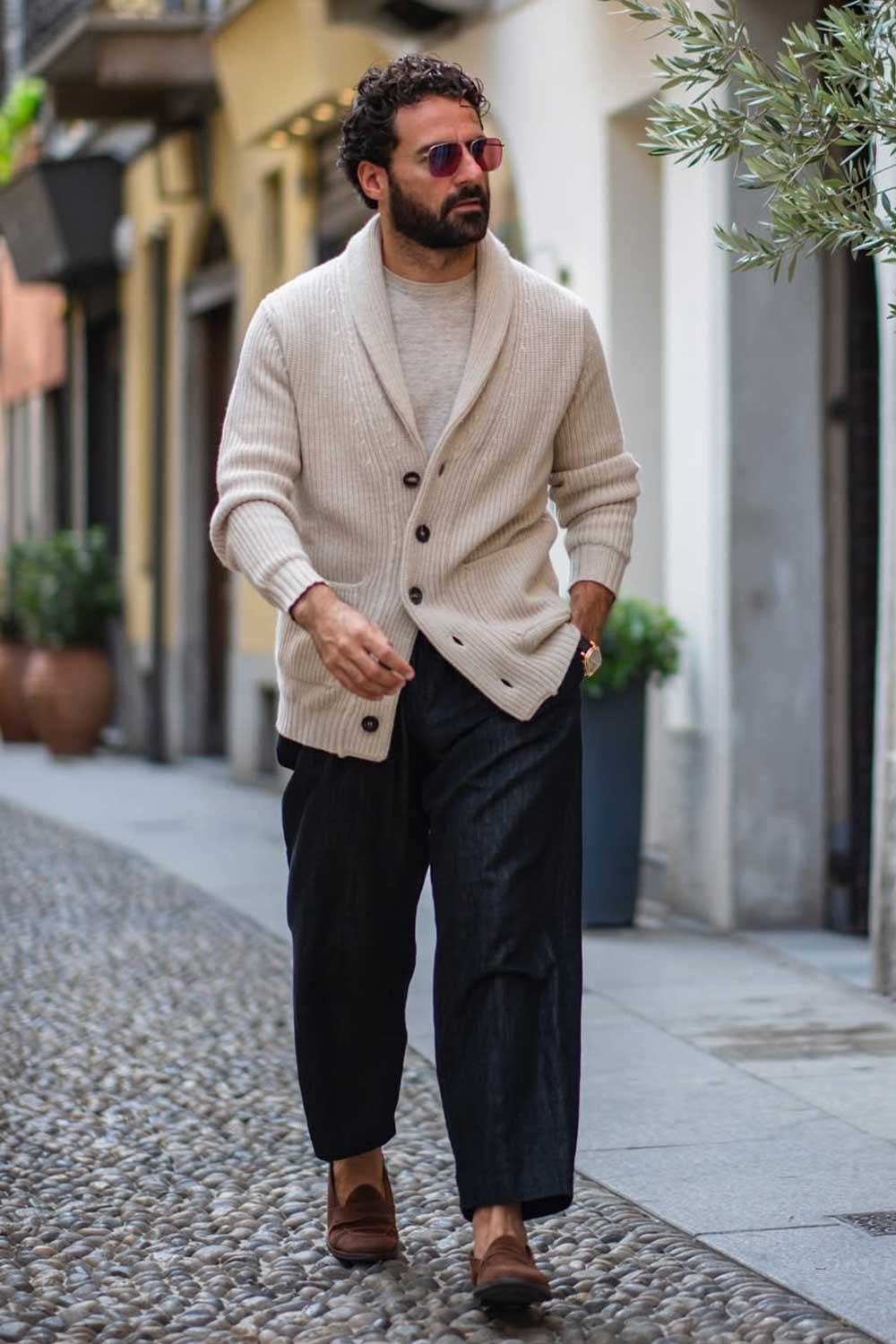 |
@toni.b_official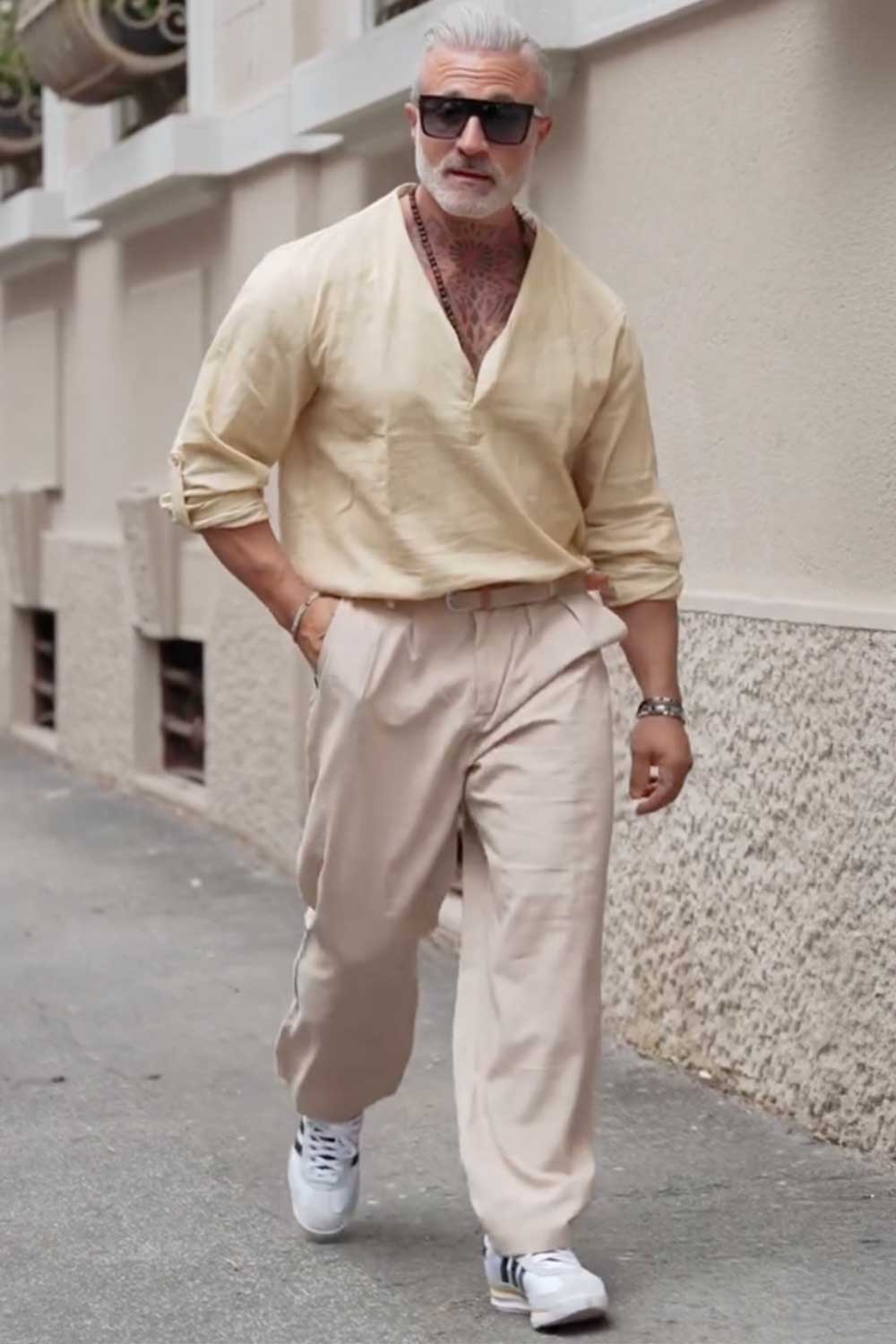 |
Milan maintains its dedication to straight-leg trousers with moderate volume, resisting the wider trend sweeping other fashion capitals.
The Milanese prefer traditional wool trousers in classic menswear colours paired with unstructured jackets and suede loafers, preserving the city’s reputation for balanced proportions.
This stance reflects Milan’s role as the guardian of classical Italian tailoring and the continued influence of sprezzatura, the art of studied nonchalance.
The straight-leg dominance solidified after Pitti Uomo 104, where major Italian houses collectively presented alternatives to the wide-leg trend.
As seen at
Kiton, Attolini, Brioni, Boglioli, Incotex, PT Torino, Loro Piana, Brunello Cucinelli, Zegna
2. Oversized Blazers

Oversized blazers in sage green, butter yellow, cream, light grey, steel blue, washed black, sand, powder blue, and pale pink dominate the current menswear landscape.
Crafted primarily in lightweight wools, cotton-linen blends, and technical fabrics, these relaxed-fit blazers mark the end of the fitted blazer era that defined the last decade.
The key elements are extended shoulders, wide lapels, and a long, boxy cut that creates a powerful yet casual silhouette when paired with slim trousers or fitted knitwear.
Paris (Le Marais, 8th Arrondissement)
@vincentcassel |
@willycartier |
Sage green and butter yellow oversized blazers have transformed Parisian menswear, replacing the fitted navy blazer as the go-to smart-casual piece.
The French interpretation pairs these blazers with straight-leg trousers and minimal trainers, abandoning the traditional blazer-with-dress-shoes combination.
This styling approach emerged from the influence of Korean fashion on Parisian luxury houses, mainly after BTS appeared in oversized Celine blazers.
The look gained significant momentum when Louis Vuitton and Saint Laurent showcased oversized cuts in their SS24 collections, solidifying Paris’s departure from fitted tailoring.
As seen at
Saint Laurent, Celine, Lemaire, AMI Paris, Sandro, The Kooples, Zara, COS, Weekday
Seoul (Gangnam, Hongdae, Apgujeong)
@jongsuk0206 |
@eunwo.o_c |
Powder blue and washed black oversized blazers dominate Seoul’s fashion districts, completely replacing the cropped blazers popular during the K-pop minimalist era.
The Korean interpretation layers these blazers over oversized white T-shirts and wide-leg trousers, creating an intentionally proportion-play aesthetic that has influenced global fashion houses.
This distinct look emerged from K-drama costume designers experimenting with traditional menswear proportions, later adopted by K-pop stars during album promotions.
The trend exploded when NewJeans and BTS members wore oversized blazers during fashion week appearances, cementing Seoul’s position as a major influence on global menswear silhouettes.
As seen at
Wooyoungmi, Juun.J, System Homme, Andersson Bell, Ader Error, Musee, Frigus, Andersson Bell
London (Mayfair, Knightsbridge, Soho)
@benhardy |
@harrisdickinson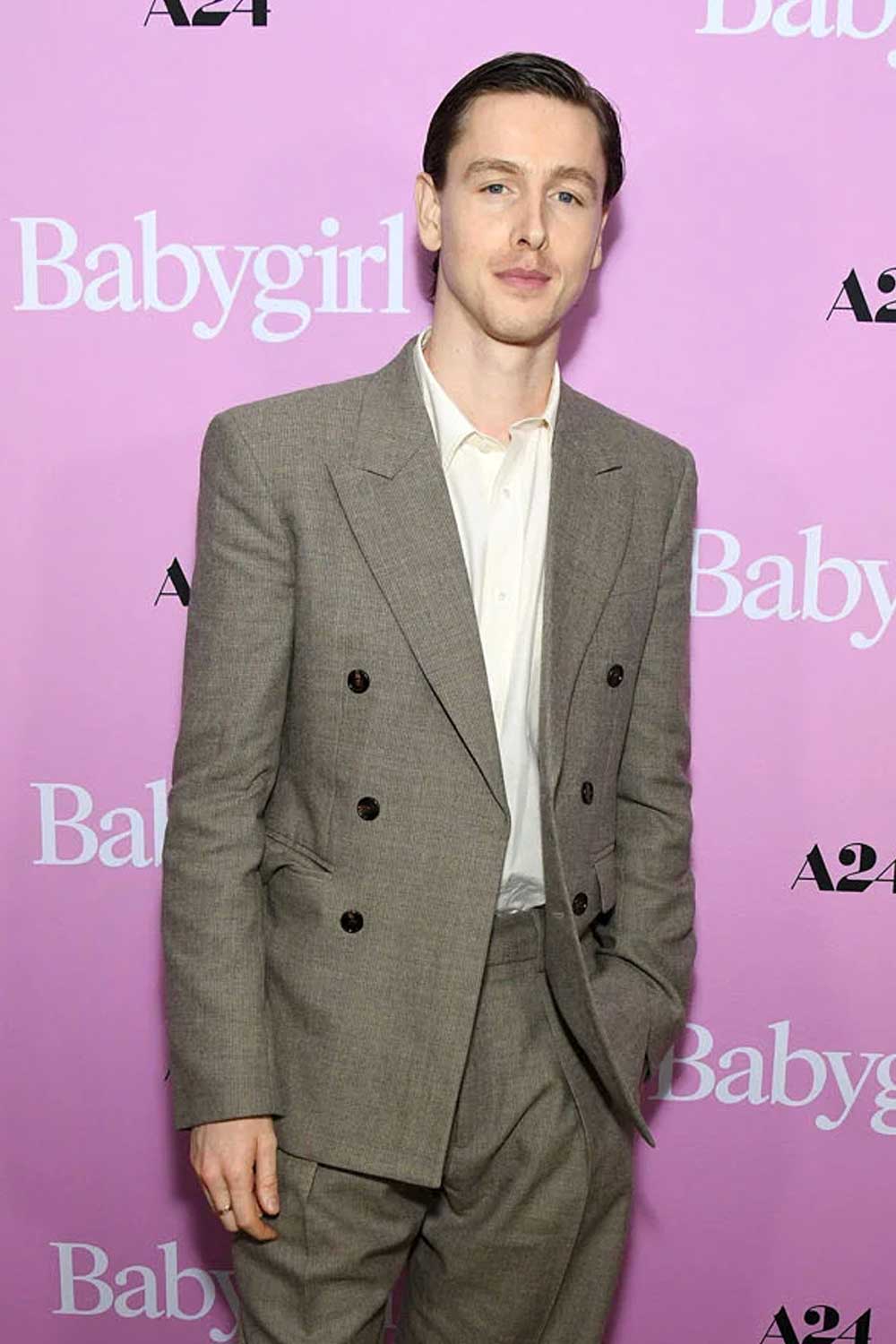 |
Cream and steel blue oversized blazers have revolutionised London’s approach to business casual, particularly in the creative and tech sectors.
The British pair these blazers with dark denim and Chelsea boots, creating a distinctive Sloane Ranger interpretation that bridges old-world tailoring with modern proportions.
This styling emerged from Savile Row tailors adapting to younger clients’ demands for relaxed fits while maintaining traditional craftsmanship.
The look cemented its place when major British fashion houses presented oversized cuts at London Fashion Week Men’s, marking a clear departure from the slim-fit Mod revival of recent years.
As seen at
Alexander McQueen, Wales Bonner, A-COLD-WALL, Dunhill, Paul Smith, Richard James
Milan (Quadrilatero della Moda)
@stevenlivingroom |
@susinnasimone |
Milan interprets the oversized trend through a softer lens, favouring natural shoulder lines and subtle volume rather than extreme proportions.
The Milanese prefer unstructured blazers in earth tones, maintaining their commitment to sprezzatura while subtly incorporating modern volumes.
This approach reflects Milan’s role as the bridge between traditional Italian tailoring and contemporary fashion, offering a more wearable interpretation of the oversized trend.
The balanced approach gained traction after Pitti Uomo, where Italian houses demonstrated how to incorporate volume without sacrificing elegance.
As seen at
Brioni, Giorgio Armani, Zegna, Boglioli, Caruso, Lardini, OVS, Gutteridge, Piazza Italia
Hong Kong (Central, Tsim Sha Tsui)
Hong Kong maintains its preference for shorter, more structured blazers, adapting the oversized trend solely through sleeve and shoulder width.
This modified interpretation pairs tailored bodies with extended shoulders, creating a unique hybrid that suits the city’s humid climate and business culture.
The approach developed as a response to the need for power dressing in Asia’s financial hub while acknowledging global trends toward relaxed tailoring.
Local tailors and luxury retailers have refined this interpretation, creating a distinctly Hong Kong take on the oversized trend influencing broader Asian markets.
As seen at
The Armoury, Attolini, Ring Jacket, Ascot Chang, The Armoury’s, WW Chan, Lane Crawford’s, Harvey Nichols
3. Double-Breasted Blazers

Double-breasted cotton blazers have displaced linen and wool versions, emerging as the definitive choice for modern smart-casual dressing across global fashion capitals.
These blazers, crafted in dense cotton twill and cotton gabardine, represent a deliberate shift away from traditional formal DBs, bringing a more relaxed approach to a classic silhouette.
The key elements combine a 6×2 button stance, slightly extended shoulders, and straight hip pockets, creating a versatile piece that pairs equally well with tailored trousers or denim.
Milan (Brera, Monte Napoleone)
Double-breasted cotton blazers in tobacco, chocolate, and olive tones have redefined Milan’s approach to spring tailoring, replacing traditional wool and linen options.
The Italian interpretation pairs these blazers with cream linen trousers and suede loafers, creating a distinctly Mediterranean take on smart-casual dressing.
This shift emerged from the Italian fashion houses’ response to younger clients seeking formal silhouettes in more casual fabrications.
The look gained momentum during Milan Fashion Week when major houses showcased cotton DBs styled with denim and t-shirts, breaking traditional formal-casual boundaries.
As seen at
Kiton, Rubinacci, Loro Piana, Boglioli, Caruso, Lardini, Massimo Alba, Slowear, Gutteridge
Paris (Le Marais, Saint-Germain)
Cotton double-breasted blazers in cream, sage, and stone have transformed Parisian casual dressing, displacing the navy wool blazer as the go-to piece for cultural events.
The French styling juxtaposes these casual DBs with raw denim jeans and minimalist trainers, abandoning traditional shirt-and-tie combinations altogether.
This interpretation gained prominence when French luxury houses began featuring artists and musicians wearing DBs with t-shirts in their campaigns.
The trend solidified after the Cannes Film Festival, where leading actors chose cotton DBs for daytime events, influencing broader European menswear.
As seen at
Saint Laurent, Officine Generale, De Fursac, Sandro, AMI Paris, The Kooples, Balibaris, L’Exception
Copenhagen (Indre By, Frederiksberg)
Scandinavian men have adopted the cotton DB in pale sand, washed black, and sea blue, replacing their signature minimalist overshirts.
The Danish approach pairs these blazers with wide-leg trousers and chunky derbies, creating an architectural silhouette that defines new Nordic elegance.
This styling emerged from Copenhagen Fashion Week’s influence on global menswear, where local designers reinterpreted traditional tailoring for the modern Scandinavian wardrobe.
The look became mainstream when major Nordic brands incorporated cotton DBs into their core collections, moving away from their previous focus on technical outerwear.
As seen at
Norse Projects, Samsøe Samsøe, Han Kjøbenhavn, Wood Wood, NN07, Selected Homme, Mads Nørgaard, Matinique, Tiger of Sweden
Singapore (Marina Bay, Orchard Road)
Singapore adopts the cotton DB trend with ultralight versions in pure cotton poplin, addressing the city’s tropical climate while maintaining professional standards.
Local interpretation focuses on pairing these lightweight DBs with tailored linen trousers and loafers, creating a humidity-appropriate take on power dressing.
The style evolved from the need to balance Western business dress codes with Southeast Asian climate demands.
This adaptation has influenced how other tropical fashion capitals approach formal dressing, creating a new standard for hot-weather tailoring.
As seen at
Kevin Seah, CYC, Benjamin Barker, The Assembly Place, Common Suits, Manifesto, Lane Crawford, Club 21, Surrender
Montreal (Mile End, Old Port)
Montreal’s take on cotton DBs emphasises texture and layering, worn year-round as part of the city’s emerging neo-prep aesthetic.
The Canadian styling pairs these blazers with rolled denim and work boots in winter, switching to canvas sneakers and linen trousers in summer.
This versatile approach developed as a response to the city’s extreme seasonal temperature variations, proving the adaptability of cotton tailoring.
The trend was cemented when Quebec’s fashion influencers began showcasing cotton DBs as year-round essentials, departing from traditional seasonal styling.
As seen at
SSENSE, Michel Brisson, Harry Rosen, Influence U, Simons, TNT, Georges Rech, Club Monaco, Frank And Oak
4. Drop-Shoulder Suits

Drop-shoulder suits have emerged as the new standard in modern tailoring, marking a decisive departure from the sharp-shouldered, Italian-inspired suits of the past decade.
Crafted in tropical wool, mohair-silk blends, and refined twills, these suits feature lowered shoulder lines, fuller chest areas, and relaxed trouser cuts.
The key elements include extended shoulder seams below the natural shoulder, deep armholes, and broader sleeves, creating a powerful, relaxed silhouette paired with casual pieces.
Stockholm (Ostermalm, Sodermalm)
Drop-shoulder suits in pebble grey, sand, and pearl have revolutionised Scandinavian workwear, replacing the sharp minimalist suits that defined Nordic business dress.
The Swedish interpretation pairs these suits with merino roll-necks and minimalist leather sneakers, creating a distinctly modern take on power dressing.
This styling emerged as major Swedish tech companies shifted toward a more sophisticated dress code, moving away from the casual startup aesthetic.
The look gained momentum when H&M Group and Spotify executives adopted drop-shoulder suits for public appearances, influencing corporate style across Northern Europe.
As seen at
Our Legacy, Acne Studios, Tiger of Sweden, Hope, Arket, Filippa K, J.Lindeberg, Oscar Jacobson, Brothers
Seoul (Gangnam, Cheongdam-dong)
Drop-shoulder suits in powder blue, soft moss, and pearl white dominate Seoul’s luxury districts, replacing the slim-fit suits popularised by K-drama leads.
The Korean interpretation layers these suits over oversized white shirts and chunky leather trainers, eschewing traditional shirt-and-tie combinations.
This styling shift emerged from K-pop’s influence on luxury fashion, particularly after BTS and BLACKPINK’s fashion week appearances in relaxed suits.
The trend cemented when major Korean corporations embraced a more creative dress code, influenced by the entertainment industry’s growing impact on business culture.
As seen at
Wooyoungmi, Solid Homme, Münn, Gentle Monster Collection, Beaker, Kusikohc, Sacai Korea, Theory Korea, Solid Homme
NYC (Financial District, TriBeCa)
Manhattan has embraced drop-shoulder suits in graphite, dove grey, and sandstone, marking Wall Street’s first significant silhouette shift since the slim-fit revolution.
New York’s take pairs these suits with crisp t-shirts and polished Chelsea boots, bridging the gap between startup casual and financial district formality.
This evolution reflects the city’s post-pandemic workplace transformation, as large banks and tech companies adopt flexible dress codes.
The style gained universal acceptance when Goldman Sachs and JP Morgan executives began wearing relaxed suits for client meetings, influencing broader corporate America.
As seen at
The Row, Fear of God, Thom Browne, Theory, Todd Snyder, Suit Supply, Saks Fifth Avenue Collection, Brooks Brothers, J.Crew
Shanghai (Jing’an, Huangpu)
Shanghai maintains a preference for modified drop-shoulder suits featuring a slightly more structured shoulder line adapted for Asian body types.
The Chinese market emphasises deep ink, slate, and cloud grey suits paired with mandarin collar shirts and minimal accessories.
This adaptation reflects Shanghai’s position as Asia’s financial hub, where traditional business culture meets contemporary luxury fashion.
Local tailors have refined this silhouette to create a distinctly Chinese interpretation of modern suiting, influencing broader Asian markets.
As seen at
Shanghai Tang, JNBY, Exception de Mixmind, Coherence, Mark Fairwhale, ZucZug, Dong Liang, Lane Crawford
Amsterdam (Oud-Zuid, Jordaan)
Amsterdam’s interpretation of drop-shoulder suits emphasises sustainable materials and relaxed styling, reflecting Dutch design principles.
The Dutch approach pairs organic wool suits with recycled polyester t-shirts and sustainable trainers, creating an eco-conscious take on modern tailoring.
This styling emerged from Amsterdam’s position as Europe’s sustainable fashion hub, where environmental consciousness meets contemporary design.
The trend solidified when major Dutch banks adopted sustainable dress codes, prompting local designers to reimagine traditional suiting.
As seen at
Delirium, Scotch & Soda, Four, Amator, Salle Privée, Suitsupply, Hans Ubbink, O My Bag, ETQ Amsterdam
5. Wool-Leather Varsity Jackets

Wool-leather varsity jackets have transcended their collegiate origins to become a luxury outerwear staple, replacing casual bombers and formal overcoats in sophisticated wardrobes.
These jackets combine premium Melton wool bodies with full-grain leather sleeves, significantly elevating from traditional varsity styles through upgraded materials and refined proportions.
The key elements merge classic varsity details – ribbed collar, cuffs, and hem – with a more streamlined silhouette and minimal branding, creating versatile outerwear that works in casual and formal settings.
LA (Beverly Hills, West Hollywood)
Varsity jackets in cream wool with cognac leather sleeves have become LA’s default smart-casual outerwear, displacing the denim jacket for evening events.
The Los Angeles interpretation pairs these jackets with tailored black trousers and loafers, creating a distinctly Hollywood take on high-low dressing.
This styling emerged from talent agencies and production companies adopting varsity jackets as their unofficial uniform, moving away from traditional blazers.
The trend exploded when major studios began gifting premium varsity jackets during awards season, influencing industry insiders and the broader luxury market.
As seen at
Golden Bear for Mr Porter, James Perse, John Elliott, Rick Owens, The Elder Statesman, RTH, American Rag, Fred Segal, Union
Tokyo (Shibuya, Harajuku)
Japanese luxury houses have reimagined varsity jackets in black Melton wool with white leather sleeves, replacing souvenir jackets and traditional blazers.
The Tokyo interpretation layers these jackets over mock-neck sweaters and wide-leg wool trousers, abandoning the casual styling of vintage varsity pieces.
This elevation emerged from Japanese streetwear brands collaborating with traditional wool mills and leather artisans, creating luxury versions of American classics.
The look was cemented when major department stores positioned varsity jackets alongside formal outerwear, establishing them as acceptable business attire.
As seen at
Fragment Design, Neighborhood, Visvim, United Arrows, Beams Plus, Beauty & Youth, Ships, Tomorrowland, Edition
London (Chelsea, Mayfair)
British menswear has adopted navy wool varsity jackets with tan leather sleeves, integrating them into traditional wardrobes alongside tweed jackets.
The London approach pairs these jackets with flannel trousers and suede loafers, creating a modern interpretation of the classic British preppy style.
This fusion developed when Savile Row tailors began offering bespoke varsity jackets, elevating them to the status of formal outerwear.
The trend gained momentum after prestigious universities commissioned luxury versions of their traditional sports jackets, influencing broader menswear.
As seen at
Private White V.C., Kent & Curwen, Dunhill, Gieves & Hawkes, Drake’s, Oliver Spencer, Hackett, Sunspel, Reiss
Beijing (Sanlitun, Chaoyang)
Beijing adapts varsity jackets with longer lengths and mandarin collars, creating a hybrid that bridges Western and Eastern design elements.
The Chinese interpretation focuses on dark wool bodies with black leather sleeves, wide-leg trousers, and minimalist sneakers.
This adaptation reflects Beijing’s growing influence in global luxury fashion brands, where traditional Western pieces are reimagined through a Chinese lens.
Local designers have refined this fusion to create a distinctly Chinese luxury sportswear category, influencing broader Asian markets.
As seen at
Npc, Random Walks, Sankuanz, Pronounce, Staffonly, Oude Waag, Lane Crawford
Melbourne (Fitzroy, South Yarra)
Melbourne emphasises lightweight construction and year-round wearability, adapting varsity jackets for Australia’s variable climate.
The Australian styling combines these jackets with tailored shorts and leather boots in summer, switching to wool trousers in winter.
This versatile approach developed from Melbourne’s position as Australia’s fashion capital, where European styles meet practical antipodean needs.
The trend solidified when Australian luxury retailers began showcasing varsity jackets as core rather than seasonal items.
As seen at
Calibre, Harrolds, P.Johnson, Incu, Service Denim, Criteria, Henry Bucks, Up There Store, Double Monk
6. Platform Loafers

Platform loafers have displaced minimalist and traditional dress shoes, emerging as the definitive footwear bridging formal and casual wardrobes.
These loafers combine traditional penny slot details, hand-stitched uppers, and substantial rubber or leather soles, representing a bold departure from chunky sneakers and classic dress shoes.

The key elements feature a 4-5cm platform sole, robust leather uppers, and traditional penny slot detailing, creating a versatile shoe that adds height while maintaining classic proportions.
London (Soho, Shoreditch)
Platform penny loafers in polished black and cordovan leather have revolutionised London’s footwear scene, replacing Doc Martens and classic Oxford shoes.
The British interpretation pairs these loafers with oversized suits and white socks, creating a distinctly modern take on traditional British subculture style.
This evolution emerged from London’s creative agencies adopting elevated footwear as their uniform, moving away from the minimalist sneaker trend.
The look gained mainstream acceptance when major British fashion houses featured platform loafers on their runway shows, influencing the luxury and high-street markets.
As seen at
Church’s, Grenson, Russell & Bromley, G.H. Bass UK, Tricker’s, Kurt Geiger, Dune London, JW Anderson
Milan (Monte Napoleone, Brera)
Italian luxury houses have refined platform penny loafers in antiqued brown and burgundy leather, replacing driving shoes and classic Goodyear-welted loafers.
The Milanese interpretation matches these loafers with cropped tailored trousers and no socks, maintaining the city’s reputation for sprezzatura while embracing modern proportions.
This styling shift emerged when Italy’s influential fashion editors adopted platform loafers for fashion week, breaking away from the city’s traditional blake-stitched footwear.
The trend was cemented after Pitti Uomo, where Italian menswear influencers showcased platform loafers as the new standard in elevated casual footwear.
As seen at
Tod’s, Car Shoe, Santoni, Premiata, Moreschi, Bally Milan, Alberto Guardiani, Fratelli Rossetti, Sebago
Tokyo (Daikanyama, Ginza)
Japanese retailers have embraced platform penny loafers in patent black and deep green leather, replacing technical sneakers and traditional dress shoes.
The Tokyo styling pairs these loafers with wide-leg wool trousers and oversized blazers, creating architectural silhouettes characteristic of Japanese fashion.
This adaptation developed through Japanese craftsmen reinterpreting American penny loafer designs with exaggerated proportions.
The look exploded when major Japanese department stores positioned platform loafers as the cornerstone of modern business-casual dressing.
As seen at
Hender Scheme, Needles, Regal Shoes Japan, United Arrows, Ships, Beams, Isetan Men’s
Seoul (Apgujeong, Cheongdam)
Seoul has adapted platform penny loafers with contrast stitching and dual-tone leathers, transforming traditional designs into statement pieces.
The Korean approach combines these loafers with cropped tailored trousers and oversized outerwear, influenced by K-pop’s impact on global fashion.
This interpretation gained prominence when leading K-drama actors wore platform loafers during press appearances.
Local department stores have dedicated sections to elevated footwear, confirming platform loafers as a critical component of Korean luxury style.
As seen at
D’Milano, Gentle Monster Boutique, Less Than Basic, Wooyoungmi, Solid Homme, Kusikohc
Stockholm (Ostermalm, Norrmalm)
Stockholm’s interpretation emphasises sustainable materials and minimal design, featuring recycled rubber soles and vegetable-tanned leathers.
The Swedish styling incorporates these loafers into monochromatic outfits, pairing them with oversized knitwear and straight-leg trousers.
This sustainable approach reflects Scandinavian design principles, where functionality meets environmental consciousness.
The trend gained momentum when Swedish fashion houses began promoting platform loafers as year-round footwear suitable for Nordic weather conditions.
As seen at
ATP Atelier, Our Legacy, Eytys, Acne Studios, CQP, Vagabond Shoemakers, Axel Arigato, Tiger of Sweden, Gram Shoes
7. Monochromatic Outfits

Monochromatic dressing has replaced high-contrast outfits and pattern mixing, establishing itself as the new standard in sophisticated menswear.
This approach combines tones and textures of the same colour, crafted in luxurious materials ranging from brushed wool and cashmere to silk-cotton blends and textured linens.
The key elements involve layering different garment types – shirts, knitwear, trousers, and outerwear – in subtly different shades of the same colour family, creating depth through texture rather than contrast.
Paris (16th Arrondissement, Le Marais)
Parisian men have adopted head-to-toe ivory and ecru outfits, abandoning the city’s traditional navy-and-white combinations.
The French interpretation layers different weights of the same shade – heavyweight ivory wool coats over fine-gauge ecru knitwear and cream trousers – creating subtle depth through texture variation.
This shift emerged when major French houses presented monochromatic collections, moving away from the pattern-mixing that dominated previous seasons.
The look gained momentum after Paris Fashion Week, where street-style influencers and photographers documented the city’s shift toward tonal dressing.
As seen at
Lemaire, AMI Paris, Officine Generale, De Fursac, Sandro Homme, The Kooples, Habilleur, L’Exception, La Garçonniere
Dubai (DIFC, Dubai Mall)
Dubai’s luxury market has embraced tonal dressing in shades of sand and alabaster, replacing the bold patterns and colours that previously dominated Gulf fashion.
The Middle Eastern interpretation combines textured summer-weight wools with silk blends, adapting monochromatic dressing for the region’s climate while maintaining luxury appeal.
This evolution reflects Dubai’s growing influence in global fashion, where traditional Middle Eastern elegance meets contemporary minimalism.
The trend solidified when local fashion influencers and business leaders adopted tonal dressing for professional and social occasions, setting a new standard for Gulf luxury.
As seen at
Boutique 1, Harvey Nichols Dubai, Burberry Dubai, Etoile, Symphony, Bloomingdale’s Dubai, Ounass, Level Shoes, Gallery One
Copenhagen (Indre By, Vesterbro)
Danish fashion has pioneered monochromatic dressing in mist grey and oatmeal shades, moving away from the region’s signature colourful minimalism.
The Scandinavian approach layers different weights and textures of knitwear with matching outerwear and trousers, creating depth through subtle tonal variations.
This styling emerged from Copenhagen Fashion Week’s influence on global menswear, where Nordic brands showcased sophisticated tonal collections.
The look became mainstream when major Scandinavian design houses incorporated full monochromatic suits into their core collections.
As seen at
Norse Projects, Samsøe Samsøe, Wood Wood, Han Kjøbenhavn, Selected Homme, NN07, Martin Asbjørn, Mark Kenly Domino Tan, Mads Nørgaard
Shanghai (The Bund, Former French Concession)
Shanghai has adapted monochromatic dressing with ink black and deep slate ensembles, eschewing traditional Chinese colourways.
The Chinese interpretation emphasises luxurious technical fabrics and modern cuts, creating a forward-looking take on tonal dressing.
This approach developed as Shanghai’s fashion scene established itself as a leader in contemporary luxury, influencing broader Asian markets.
Major Chinese fashion houses have refined this aesthetic, creating collections that bridge Eastern and Western design sensibilities.
As seen at
Eden Shanghai, Juice Shanghai, Lane Crawford, 10 Corso Como, Triple Major, Doe, ENG Concept Store, Dong Liang, Labelhood
Melbourne (Collins Street, Fitzroy)
Melbourne’s fashion scene has embraced monochromatic dressing in shades of charcoal and cement, adapting the trend for the city’s famously variable weather.
The Australian interpretation focuses on garments with different weights, allowing for easy adaptation to sudden temperature changes.
This practical approach emerged from Melbourne’s position as Australia’s fashion capital, where European trends meet Southern Hemisphere practicality.
The style gained traction when Australian luxury retailers began merchandising their collections in monochromatic stories rather than by product category.
As seen at
Harrolds, Calibre, P. Johnson, Suit Shop, Mr Porter’s, Incu, Service, Pickings & Parry
8. Patterned Mohair Sweaters

Patterned mohair sweaters have displaced traditional wool knits and casual sweatshirts, establishing themselves as the new cornerstone of luxury casual wear.
These sweaters merge geometric and abstract patterns in brushed mohair, mohair-silk, and mohair-wool blends, shifting from plain knitwear to statement pieces.
The key elements combine oversized fits with intricate jacquard patterns and textural mohair finishes, creating sophisticated knitwear that works equally well with tailoring or denim.
Madrid (Salamanca District)
Spanish luxury houses have embraced geometric patterned mohair knits, replacing the fine-gauge merino sweaters that dominated previous seasons.
The Madrid interpretation pairs these statement sweaters with tailored wool trousers and leather loafers, creating a distinctly Mediterranean approach to luxury casual wear.
This styling emerged when major Spanish department stores positioned mohair knits as the new standard in elevated weekend dressing.
The trend gained momentum after Loewe’s influential mohair collections influenced local and international markets.
As seen at
Loewe, Adolfo Dominguez, Roberto Verino, Pedro del Hierro, Tenkey, El Ganso, Scalpers, Edmmond Studios, Bimba y Lola
Montreal (Golden Square Mile)
Montreal’s luxury retailers have championed bold geometric mohair knits, shifting away from the heritage wool sweaters that previously defined Canadian luxury knitwear.
The Quebec interpretation layers these statement sweaters under tailored wool overcoats with raw denim, creating a sophisticated response to extreme winters.
This evolution stems from Montreal’s position as a French-influenced fashion hub in North America, where European luxury meets North American casual wear.
The trend solidified when major Canadian retailers began positioning mohair knits as investment garments, footwear, and accessories rather than seasonal pieces.
As seen at
Simons, Holt Renfrew, Harry Rosen, Michel Brisson, Rooney, SSENSE, TNT, Want Apothecary, Georges Rech
Lisbon (Avenida da Liberdade)
Portuguese menswear has adopted abstract patterned mohair sweaters, moving away from the city’s traditional fine merino and cotton knits.
The Lisbon approach combines these textured sweaters with lightweight wool suits and leather sneakers, adapting luxury knitwear for the Atlantic climate.
This styling emerged from Portugal’s growing influence in luxury textiles, where traditional craftsmanship meets contemporary design.
The look gained prominence when major Portuguese mills began developing exclusive mohair blends for luxury brands.
As seen at
Storytailors, Fashion Clinic, Stivali, Rosa & Teixeira, Manuel Ritz, Fatima Lopes, Miguel Vieira, Luis Onofre, Nuno Gama
Boston (Back Bay, Beacon Hill)
Boston’s traditional luxury retailers have embraced patterned mohair as an elevated alternative to Ivy League staples.
The New England interpretation pairs these sweaters with tailored corduroy trousers and suede loafers, updating preppy classics for contemporary wardrobes.
This adaptation reflects Boston’s evolution from traditional American style to contemporary luxury, influenced by its international student population.
The trend cemented when heritage retailers began featuring mohair alongside traditional cashmere in their winter collections.
As seen at
Louis Boston, Alan Bilzerian, Riccardi, Barneys at Copley, Neiman Marcus, Saks Fifth Avenue, Max Mara, Serenella, Ball and Buck
Munich (Maximilianstrasse)
Munich’s luxury boutiques have repositioned patterned mohair knits as essentials in the modern German wardrobe.
The current German fashion trends for men layers sweaters under classic leather outerwear with wool trousers, creating a sophisticated approach to winter dressing.
This styling developed from Munich’s position as Germany’s luxury capital, where traditional craftsmanship meets contemporary fashion.
The trend gained traction when German luxury department stores began dedicating entire sections to statement knitwear.
As seen at
Lodenfrey, Hirmer, Anson’s, Schwittenberg, Konen, Theresa, Mytheresa, Unger, Apropos
9. Slouchy Vintage-Wash Jeans
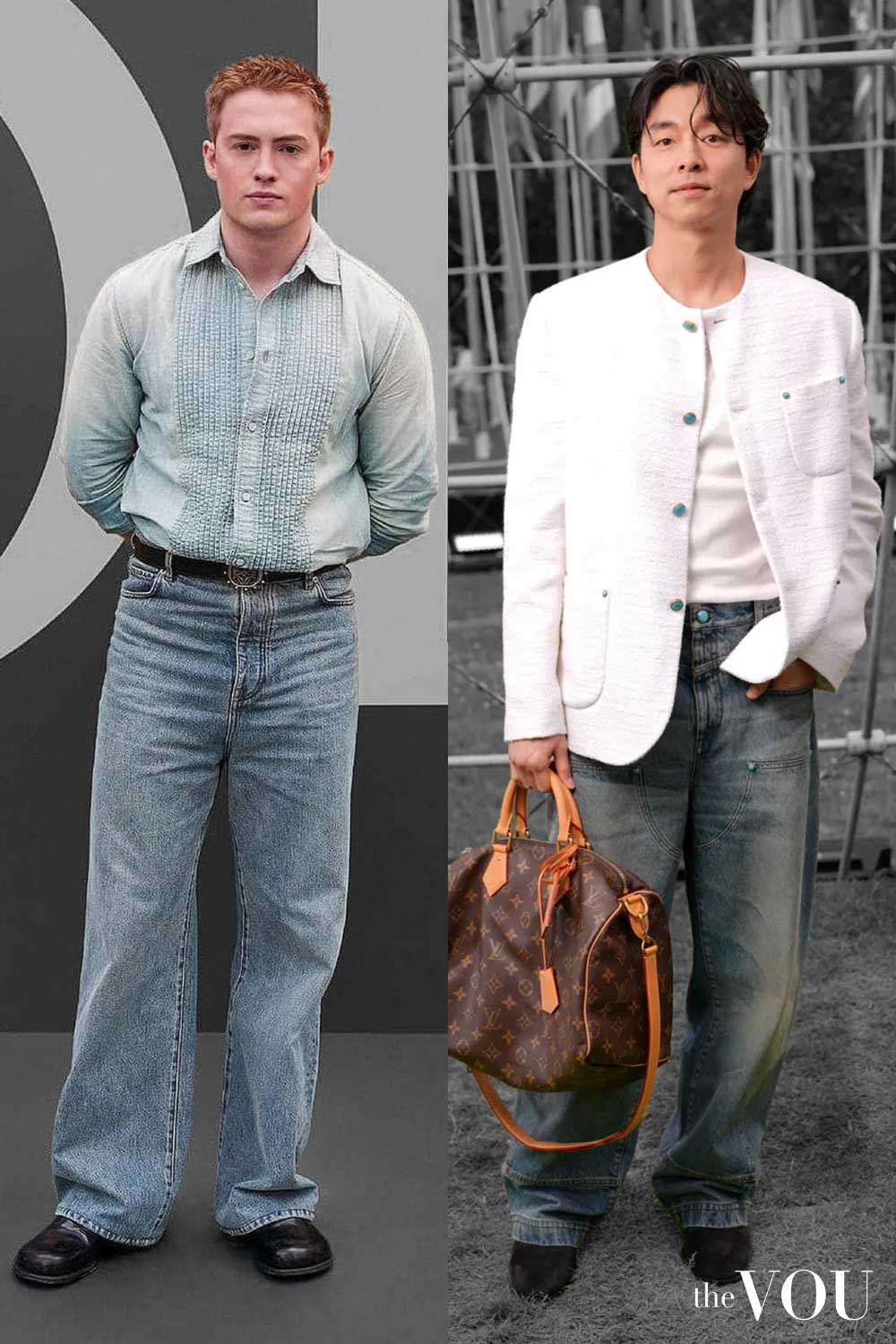
Slouchy vintage-wash denim has displaced both slim-fit and raw denim, marking the most significant shift in luxury denim since the skinny jeans era.
These jeans feature subtle distressing, authentic fading patterns, and relaxed fits through the hip and thigh, crafted in premium Japanese and Italian denim with distinctive vintage-inspired washes.
The key elements combine a higher rise, relaxed thigh, and a gentle taper from the knee down, creating a sophisticated silhouette that works with both tailored and casual pieces.
Paris (Le Marais)
Parisian luxury houses have embraced slouchy vintage denim, moving away from their signature raw selvedge jeans.
The French interpretation pairs these jeans with tailored blazers and leather loafers, creating a distinctly Parisian take on high-low dressing.
This styling emerged when major French luxury brands began featuring vintage washes in their permanent collections, moving away from rigid denim.
The trend gained momentum after Paris Fashion Week, where street style highlighted the shift from skinny to slouchy fits.
As seen at
A.P.C., ACNE Studios Paris, Officine Générale, AMI Paris, The Kooples, Isabel Marant, L’Exception, Merci, Le Bon Marche
Rome (Via Condotti, Via del Babuino)
Italian luxury menswear retailers have adopted slouchy vintage denim as an alternative to their traditional tailored trousers.
The Roman interpretation matches these jeans with unstructured cashmere blazers and suede loafers, creating a relaxed take on Mediterranean elegance.
This evolution reflects Rome’s shifting perspective on casual luxury, where denim has become acceptable in previously formal settings.
The trend solidified when iconic Italian houses began incorporating vintage-wash denim into their luxury casual collections.
As seen at
Zegna, Brioni, Brunello Cucinelli, Kiton Roma, Borrelli, Battistoni, Boggi Milano, Corneliani, Canali
San Francisco (Hayes Valley, Pacific Heights)
Silicon Valley’s influence has transformed slouchy vintage denim into acceptable office wear, replacing chinos and dress trousers.
The Bay Area approach pairs these jeans with tech Merino knits and minimal sneakers, creating a new standard for professional, casual dressing.
This styling emerged when major tech companies updated their dress codes, elevating denim from casual Friday to everyday wear.
The look became mainstream when venture capital firms and tech executives embraced vintage denim for meetings and presentations.
As seen at
RRL, Self Edge, AB Fits, Unionmade, American Rag, The Jean Shop, Denim Bar at Bloomingdale’s, Neiman Marcus, Barney’s
Amsterdam (P.C. Hooftstraat)
Dutch fashion has embraced slouchy vintage denim, integrating it with the city’s established denim heritage.
The Amsterdam interpretation focuses on sustainable washes and ethical production, pairing these jeans with oversized knits and Chelsea boots.
This approach developed from Amsterdam’s position as Europe’s denim capital, where innovation meets sustainability.
The trend became prominent when Dutch denim houses featured recycled and responsibly washed vintage styles.
As seen at
Denham, G-Star RAW, Scotch & Soda, Kings of Indigo, FOUR Amsterdam, Tenue de Nîmes, Frans Boone, Van Ravenstein, The Society Shop
Vancouver (Gastown, Alberni Street)
Vancouver’s luxury retailers have adopted slouchy vintage denim to answer the city’s casual-meets-luxury aesthetic.
The Canadian West Coast pairs these jeans with technical outerwear and artisanal boots, adapting vintage denim for the Pacific Northwest lifestyle.
This styling reflects Vancouver’s position as a bridge between North American casual wear and Asian luxury influences.
The look became a trend when major Canadian department stores featured vintage-wash denim alongside designer collections.
As seen at
Roden Gray, Haven, Neighbour, The Block, Holt Renfrew, Nordstrom Vancouver, Leone, Brooklyn Clothing, Brian’s
10. Cotton Rugby Shirts

Rugby shirts have transcended their sporting origins to become luxury casualwear essentials, replacing polo shirts and casual button-downs in sophisticated wardrobes.
These pieces feature heavyweight cotton construction, bold stripe patterns, and rubber buttons, elevated through superior materials and refined proportions beyond their athletic heritage.
The key elements combine oversized fits with robust cotton jersey, traditional striped patterns, and reinforced plackets, creating versatile pieces that work equally well under tailoring or with casual wear.
London (Chelsea, Mayfair)
British luxury retailers have repositioned rugby shirts as elevated casualwear, moving away from traditional sporting associations.
The London interpretation layers these shirts under tailored overcoats with pressed wool trousers, transforming athletic wear into sophisticated daywear.
This evolution emerged when heritage brands began crafting rugby shirts in luxury materials, elevating them from their prep school origins.
The trend gained momentum after prominent British designers featured rugby shirts in their runway collections, influencing local and international markets.
As seen at
Drake’s, Ralph Lauren Purple Label, Kent & Curwen, Hackett London, Paul Smith, Private White V.C., Sunspel, Burberry, Dunhill
Boston (Newbury Street, Beacon Hill)
New England’s luxury retailers have reclaimed rugby shirts as elevated weekend wear, evolving beyond their Ivy League associations.
The Boston approach pairs these shirts with tailored chinos and suede loafers, creating a sophisticated update to traditional preppy style.
This reinterpretation reflects Boston’s evolution from collegiate classics to contemporary luxury, influenced by heritage and modern design.
The trend solidified when major American luxury brands began featuring rugby shirts in their main collections rather than sports-inspired lines.
As seen at
Brooks Brothers, J.Press, Andover Shop, Ball and Buck, Bodega, Concepts, Saks Fifth Avenue, Neiman Marcus, Louis Boston
Milan (Via Montenapoleone)
Italian luxury houses have refined rugby shirts with sophisticated stripes and premium materials, moving away from traditional sporty designs.
The Milanese interpretation combines these shirts with tailored denim and suede jackets, creating an elevated take on weekend wear.
This styling emerged when Italian designers began crafting rugby shirts in fine cotton jerseys, incorporating them into luxury casual collections.
The look gained prominence after Pitti Uomo, where Italian brands showcased refined interpretations of classic rugby shirts.
As seen at
Loro Piana, Brunello Cucinelli, Ermenegildo Zegna, Boglioli, Caruso, Slowear, Isaia, Kiton, Al Duca d’Aosta
Toronto (Yorkville, Bloor Street)
Toronto’s luxury market has embraced rugby shirts as year-round staples, adapting them for harsh winters and humid summers.
The Canadian interpretation layers these pieces under wool overcoats in winter and pairs them with tailored shorts in summer, creating versatile seasonal wardrobes.
This adaptation reflects Toronto’s need for adaptable luxury casualwear that works across extreme seasons.
Rugby shirts became a trend in Toronto after major Canadian luxury retailers positioned them as core Preppy garments rather than seasonal items.
As seen at
Harry Rosen, Holt Renfrew, TNT, Uncle Otis, Lost & Found, CNTRBND, Nicholas Metivier, Sydney’s, Via Cavour
Stockholm (Ostermalm)
Swedish luxury retailers have adopted rugby shirts with minimalist stripes and monochromatic colour schemes, adapting the style to Scandinavian aesthetics.
The Stockholm approach pairs these shirts with raw denim and minimal sneakers, creating a distinctly Nordic interpretation of preppy style.
This evolution emerged from Scandinavia’s growing influence on casual luxury fashion, where traditional pieces are refined through minimalist design.
The look gained traction when major Swedish brands incorporated rugby shirts into their core collections, presenting them as luxury essentials.
As seen at
Our Legacy, Acne Studios, Tiger of Sweden, NK Stockholm, Très Bien, C.QP, Berg & Berg, Nitty Gritty, Gabucci
The Complete Picture
In today’s rapidly evolving fashion landscape, staying ahead of current trends isn’t merely about looking stylish—it’s about making informed choices that enhance your brand and professional presence.
As we navigate 2025, the latest men’s fashion trends reflect a sophisticated fusion of comfort, sustainability, and cultural influences from global fashion capitals.
Wide-leg trousers, drop-shoulder suits, and platform penny loafers are frequently combined in financial centres, marking a definitive shift from slim-fit tailoring:
– London and NYC bankers pair wide-leg trousers with drop-shoulder blazers
– Paris and Milan combine platform penny loafers with modern old-money tailoring
– Tokyo and Seoul lead with extreme silhouettes and proportions in all three trends
Double-breasted cotton blazers, slouchy vintage jeans, and patterned mohair sweaters create new casual-formal combinations:
– Madrid and Lisbon mix mohair knits with cotton DBs
– Paris and Milan pair slouchy denim with cotton blazers
– Boston and Toronto layer all three for an elevated weekend look
Style Like A True Gentleman
Before we say goodbye, here’s one of the best-kept secrets in men’s styling circles, a secret that only a few expert image consultants know or are willing to share.
First and foremost, professional styling requires knowing your unique body shape and seasonal colour palette – paramount factors in choosing perfectly fitting clothes in colours that complement your skin, eyes, and hair.
Only then can a stylist engage in styling by occasion, location, season, and time of day, with garments, footwear, and accessories from stylistically relevant heritage fashion brands to depict high confidence and success.
Best part? You can find your body shape, seasonal colour palette, and ideal fashion style in less than 5 minutes by yourself, for free, thanks to our four simple steps:
1. Find Your Body Shape
Different garments flatter different silhouettes, so knowing your body shape is the first step in dressing like a confident man.
To find out your unique body shape, take our free body shape quiz for men.
Once you know your unique body shape, take the second free quiz to discover your unique colour palette.
2. Find Your Unique Colour Palette
Remember, the garments that compose your outfits come in various colours, and you must ensure that each hue complements your natural colour.
To do that, you have to find out your seasonal colour palette, and you can do it by taking our free seasonal colour quiz for men.
3. Find Your Ideal Fashion Style
By now, you should already know your body shape and unique colour palette; the next step is to discover your ideal personal fashion style.
The fastest and simplest way is to take our free fashion style quiz for men; it includes your ideal style, outfit ideas, relevant fashion brands, and much more.
4. Professional Image Consultancy with The VOU
And if you want to style like a professional, by occasion, location, season, and time of the day, you can always ask our expert image consultants and fashion stylists for help.
Our styling services for men are the most comprehensive and detailed on the market, backed up by leading stylists who will guide you step by step in creating looks that communicate affluence, elegance, and endless accomplishments.
Remember, wearing luxury brands isn’t enough; to look stylish, confident, and successful, you must first know your body shape, colour palette, and ideal personal style, and only then style by occasion, location, season, and time of day.
Contact us today to save headaches, time, and money – it’s time to dress like a confident, successful gentleman of exquisite fashion taste – the first styling assessment is on us!
With years of expertise in high-end fashion collabs and a PhD in Sustainable Fashion, Ru specialises in eco-luxe wardrobes for the modern gentleman seeking understated refinement.


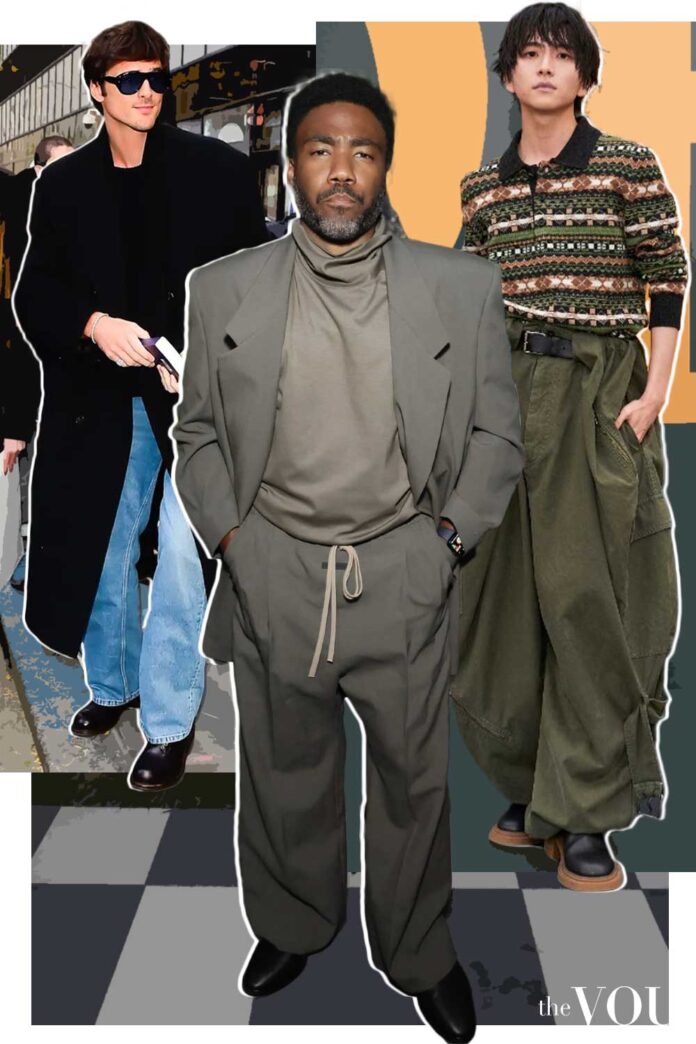
I came across this article and refreshed my husbands wardrobe following some of your tips here. Can you create a similar take on the latest fashion trends for women as well?
Agreed with JUTTRIA, there should be an article covering the latest fashion trends for women as well.
Also, are these the same fashion trends in London and Tokyo or New York at the same time?
I think somebody asked this before but are these the trends in London or New York? And do the brands stay similar as some European clothing brands are not that popular in the states?
South American fashion trends are somehow different than the European ones. For example, there’s a lot of Mexican Gaucho influences and Brazilian beachwewar so please create a specific article about men’s latest fashion trends in South America, please?!!!
Thanks for sharing detailed article about current fashion and trend.
You’re more than welcome, let us know what you’d like us to cover next. Also, don’t forget to give our podcast for men a try, you’ll love it.
Just like the others asking, are these fashion trends for men applicable to India or South America or just the UK and USA?
Staying ahead of the curve in today’s quickly changing fashion scene involves more than just looking chic; it also involves making wise decisions that advance your brand and professional image. The newest trends in men’s fashion for 2025 show a chic combination of sustainability, comfort, and cultural inspiration from major fashion cities worldwide.
Мне нравятся новые тенденции, но они немного отличаются от российских, особенно здесь, в Москве, где сочетаются европейское и азиатское влияние. Пишу на русском так проще, на моей клавиатуре не хватает некоторых символов
I love the relaxed silhouettes in the current men’s fashion trends! It’s great to see comfort becoming a priority while still looking stylish. What do you think about the elevated casual menswear?